
Set Description
US PATTERNS AND TRIAL PIECES
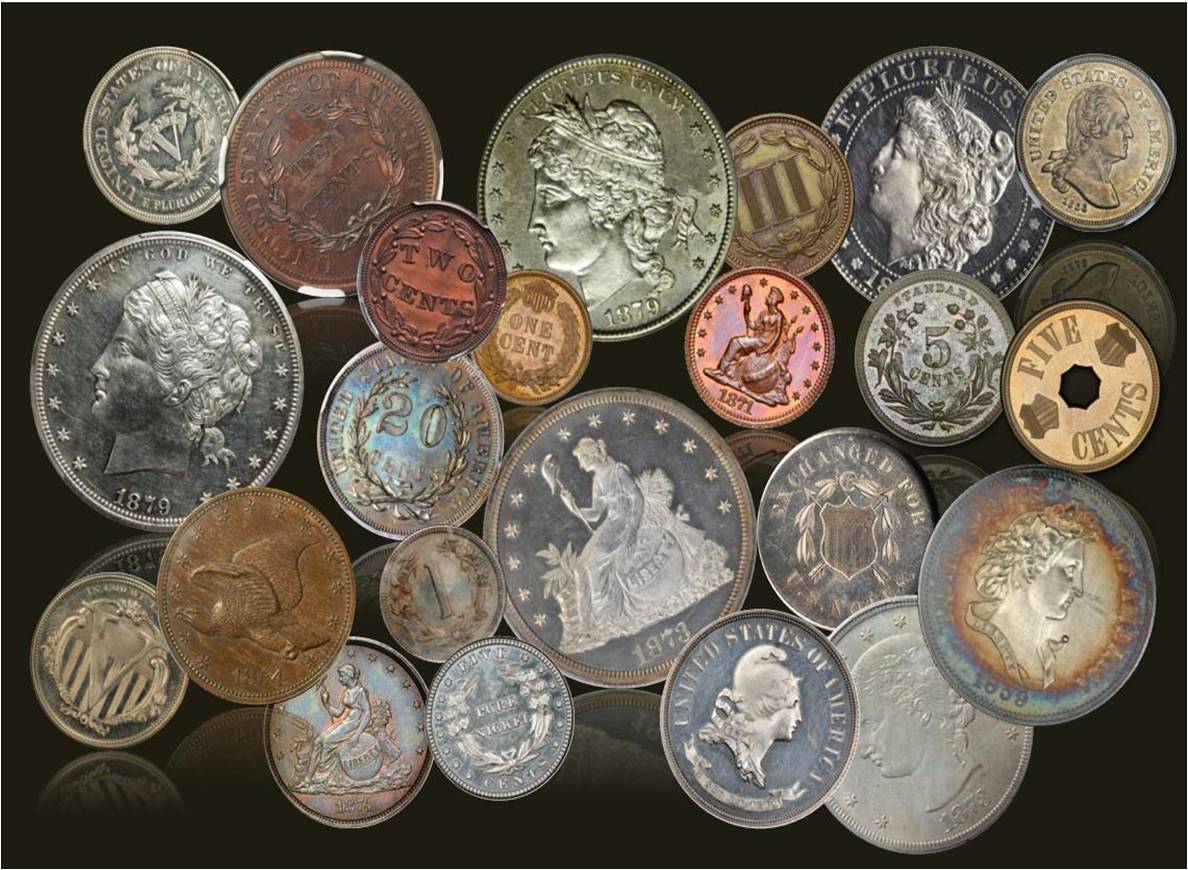
Trial and Pattern pieces had been struck since the origin of the mint. These samples and trials represent in most part the many attempts to create and improve our US coinage and provide a glimpse of what our American coinage could have been. Most of the patterns appeared concentrated in mid to later part of the 19th century. They represent amazing examples of creative engravers and their art work. Combined these designs with the mint learning process in coinage and metallurgy, and then overlay with the suspense around some of back door connections for private collectors, adds multiple layers for one to enjoy this specialty in numismatics. I personally love the history of patterns starting with the early designs to claim our nation identity. The 1792 patterns - the BIRCH Cent, DISME and the Quarter dollar share the theme of our nation independence and hard fought fight for freedoms, and these themes resonated through the history of our coinage evolution and related patterns and remain with the US coins of today -- "LIBERTY", the people, and the Strength of our resolve displayed by the American Eagle motif.
This registry set showcases my master Pattern listings that I have been assembling starting 20 years ago. While the 300 + pieces may seem as an enigma of a collection, I actually have a road map in my collection process..
I started with a simple goal to obtain sample patterns to lead into several of my regular series. Around 2004 I picked up my 1st pattern, an 1858 Indian head cent (J-211), to complement my Mint State Indian Head collection and then I followed up with a 1882 Liberty Head Nickel Pattern to lead my Proof Liberty Head 5C set. Then the bug hit me and I sought out a few other pieces to start a short type set of one for each none gold denomination.
After achieving the 1 piece per denomination, I then turned to working on several short sets and what I like to call Proof sets. These short sets are to display either examples a die combinations within a specific motif design or trial themes, or a Proof set approach where a specific Obverse and Reverse combination was used across the spectrum of the denomination (i.e. 1c through 1$). I have extracted these themes from this master Pattern Registry and created multiple Mini sets or Proof sets for display with their own Registry (Mania ) using this NGC registry. This master set displays all of the patterns in order of their JUDD reference numbers. Below are links to my Pattern Registry sub-sets.
My collecting approach, in most cases, has only focused on the design types - not the metals struck or the edge type (Plain or reeded). As such, my proof sets and sub-sets may have a mixture of Silver, Copper, and Aluminum samples of the design.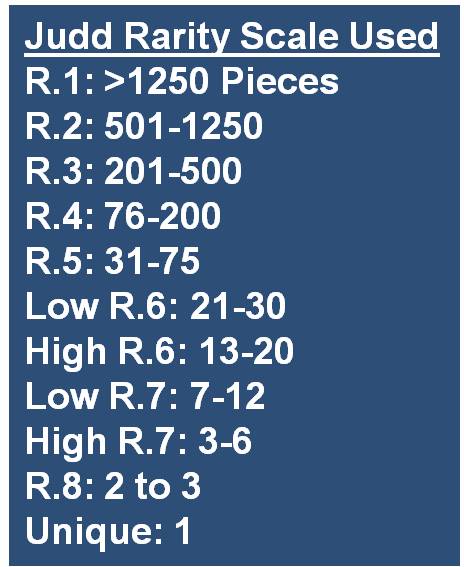
I have included a brief description of all the pieces, leveraging the information provided by the sellers and auction houses, and where documented I have also noted any Pedigree or prior appearances.. These pedigrees add another historical dimension to collecting patterns as many can be traced back to renowned collectors. Thanks to the Newman Portal and their scan archive of most auction company catalogues I have been able to track many of my pieces to earlier appearances. This has been fun but limited as photos were only more common since the 80's and prior many were poor images or stock images. The Rarity scale used in the description of each coin follows the scale published in "UNITED STATES PATTERN COINS" 10 EDITION By J. Hewitt Judd.
Current set focus areas have been.
- Standard Silver (10c, 25c and 50c) Bust & reverse variations for 1869 and 1870,
- Washington Bust, Coronet Liberty, and Shield Nickel 5c series - displaying the various obverse and reverse combinations,
- Barber Liberty Head design series 1881 - 1883 and the small denomination series of 1881,
- 1858 1c Flying Eagle and Indian Head set ( the 12 piece set),
- Trade Dollar Patterns 6 piece set,
- Barber's (1870 Liberty Seated Left) and Longacre's (1871 Princess) motif type series,
- Sample of 20 Cent patterns and their die variations,
- Goloid Dollars of 1878, 1879 and 1880 showing the different obverse bust and reverse types,
And several others
Specific registry sets for my sub-sets (currently at 21) are below:
(Click on links below to view the specific NGC custom registry)
- - Evolution of the Small US One Cent Piece
- - 1858 1C Patterns - Grounding the Eagle
- - 1859 Longacre and Paquet's Half Dollar Patterns
- - ACT OF MAY 16, 1866: Authorization of the Nickel 5C
- - Barber Liberty Head Patterns – “You’re joshing me”!
- - Liberty Coronet Pattern 5 CENT Type Set
- - Uniformity – 1868 Low Denomination Currency
- - Postage Currency
- - The Double Dime - 20 Cent Pattern Type Set
- - IN GOD WE TRUST
- - 1865 - Liberty Seated Proof Set IN COPPER and Other Off Metal Strikes"
- - Large Cent Obverse Patterns (1863-1868)
- - Liberty Bust Standard Silver Type Set - Please Stop Hoarding
- - Barber Seated Patterns of 1870 ... Please sit facing the other direction
- - Indian Princess Patterns Type Set
- - Goloid Metric Dollar Patterns- "Counterfeiters' Delight"
- - US Trade Dollar Pattern Type Set
- - Morgan Dollars ... Thank you ROYAL MINT OF ENGLAND
- - US Gold Pattern Pieces- ANYTHING BUT GOLD
- - THE PARTY SEEMS OVER ... Patterns Winding down In1884
- - Off Metal Strike - Aluminum
Collections Sorted into Denomination Sets
- - 1/2C and 1 Cent Pattern Set
- - 2C and 3 Cent Pattern Set
- - 5C ( Nickels) and Half Dime Pattern Set
- - 10C (Dime) Pattern Set
- - 25C (Quarter Dollar) Pattern Set
- - 50C (Half Dollar) Pattern Set
- - 1$ (Dollars Including Trade) Pattern Set
===================
In addition, to locate a specific piece in my collection, I have a custom set with easy links to the specific Judd number, This set does not require scrolling through pages to find or view a specific coin profile.
COIN LISTING BY JUDD
For Information on US Patterns I found the following to be the most useful:
- "United States Pattern Coins" by J. Hewitt Judd, M.D. 10th Edition 2008
- "United States Patterns and Related Issues" by Andrew W. Pollock III 1994
- "US PATTERN.COM" a pure web site on USpatterns and trial pieces by Saul Teichman and Andy Lustig ... US PATTERNS.COM
- "Collecting Patterns featuring the Bob Simpson Collection" By Heritage Auctions- this is nice simple guide to patterns and ways to think about them in collecting... Collecting Patterns
- "NUMISMATIC ARTS IN AMERICA Aesthetics of United State Coinage" by Cornelius Vermeule 1971
- Newman Portal at Washington University in St. Louis Newman Portal
This is a work in progress I hope you will find interesting.
Set Goals
Assemble series of US Patterns to form type sets within a denomination or with a specific design motif. Build a photo gallery to highlight these sets and variations of the series and showcase the collection in that suite of registries.
| | | | | | |
| | | | | | |
|
View Coin
| J-A1870-2 50C Reverse splasher |
United States
|
1870 J-A1870-2 50C Reverse Splasher
|
PCGS Genuine
|
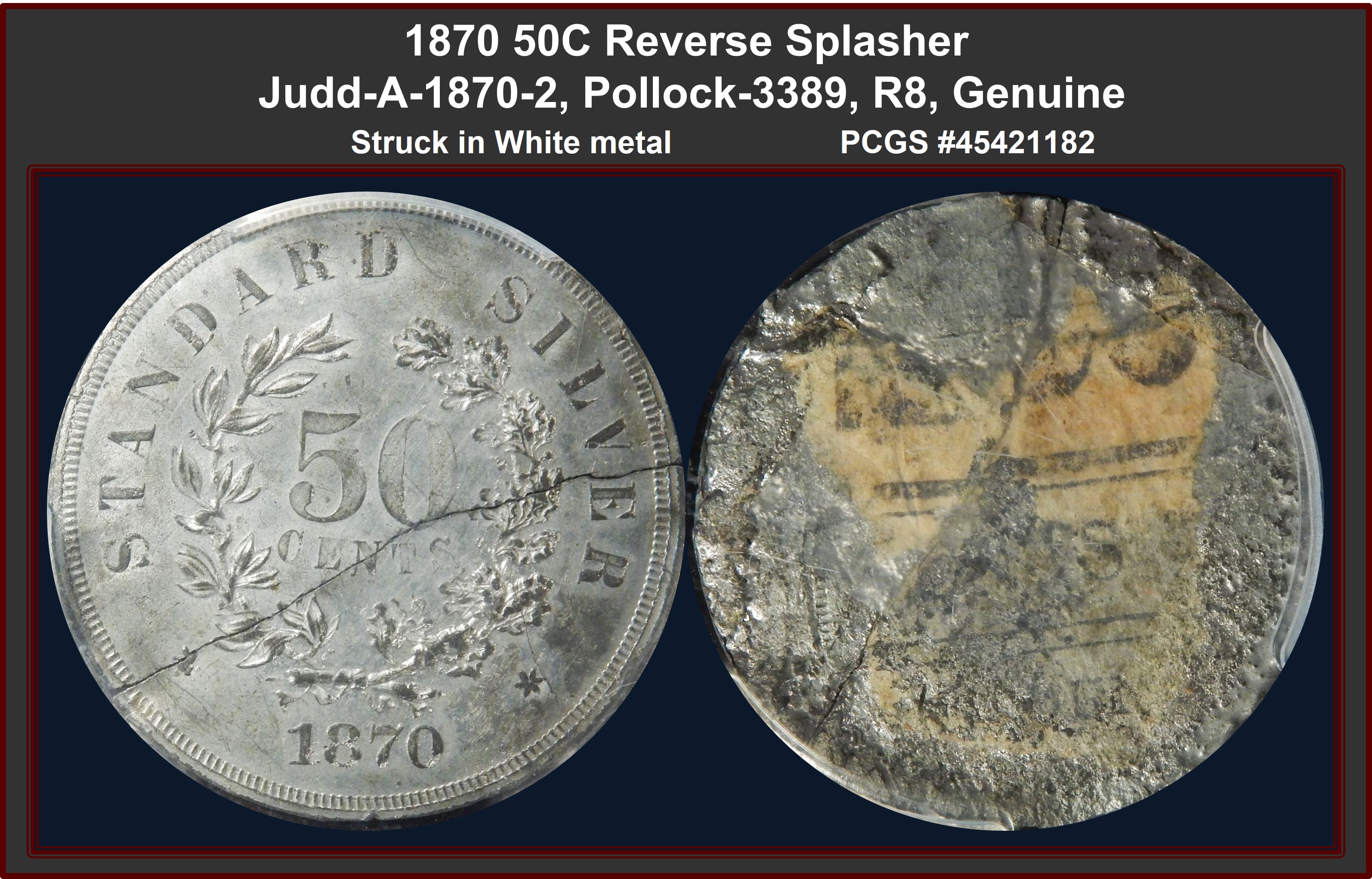
1970 50C Reverse Splasher
Judd-A-1870-2 Pollock-3389,
Rarity: R.8, GENUINE
Struck in white metal broken into 2
Judd-A-1870-2 Pollock 3389 2 Know of this type but the A-1870-2 in unique and is the plate piece in Judd 10th edition. This piece as noted in the Pollock reference as unique at the time as only this piece was known however the J-A1870-1 in a whole sample
Obverse/Reverse:
A reverse “splasher” or die trial, struck on a thin white metal or lead uniface disk. Disk is now cracked from 3:00 to the center, then diagonally down toward 8:00. Typical STANDARD SILVER reverse, with that legend around a wreath, date below, denomination within. Reverse of the present piece with old newsprint adhering as made.
Comment:
Back in 2005 the piece was auction and accompanied by a B. Max Mehl envelope, upon which was reported written “Pattern Half Dollar, (1870) / Type of A-W 895 to 918. Reverse / only. Fine. Very rare; Probably / unique.” Also on the envelope is $10. over a lowercase “c” and appearing as a fraction, along with PAGE ITEM in red ink, a 10 crossed out and 15 following PAGE, and with 5 Following ITEM.
The PCGS label noted this as a J-A1870-1 however it is the -2
Provenances/Appearances:
From Legends Feb 2023 Auction 57, Prior
Ex B. Max Mehl; Stack's, March 1993, lot 2551; ANR, July 2005, /lot 63; Glorious Patterns Collection, Part II, Legends May 2022, / Lot 321 (where it was uncertified).
|

|
|
View Coin
| J-A1875-1 20C Die Trial |
United States
|
White Metal 20C 1875 J-A1875-1 Die Trial Ex: Nagy / Kosoff
|
PCGS MS 63
|
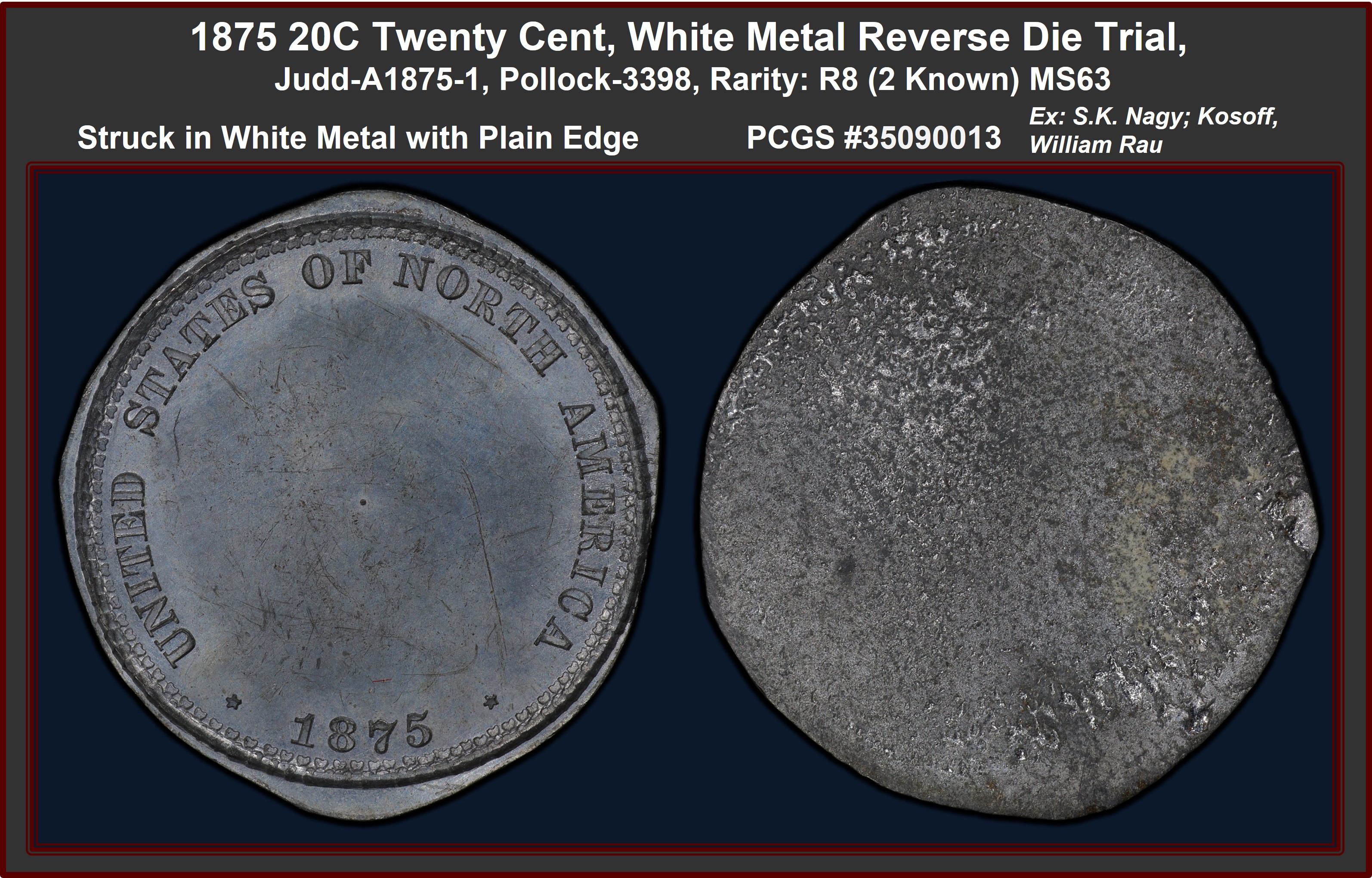
1875 20C Twenty Cent, White Metal Reverse Die Trial,
Judd-A1875-1, Pollock-3398,
Rarity: R.8 ( Only 2 known) MS63
Plate Coin Pollock fig 669
.
Struck in White Metal with plain edge
Obverse: This uniface die trial shows UNITED STATES OF NORTH AMERICA across the upper obverse with the date below. No central device is present.
Reverse: Unstruck
Comment:
This is one of two examples known. Saul Teichman, writing for USPatterns.com, explains: "It is unclear if this [is] for an obverse or a reverse design or if it is really for a 20 cent piece. It is more likely a design for a medal or token of some sort."
The pewter-gray obverse is partly lustrous, and the devices on that side are sharp. A small centering dot is apparent. The unstruck reverse is rough and porous.
20.0 Grains
Provenance/ Appearances:
Ex: S.K. Nagy; KOSOFF, A . 8/13/1958 ANA convention Auction sale /Lot #2050;
- Kosoff Sale (Bowers and Merena, 11/1985) / lot #1145;
- Superior (2/1991)/ Lot #1920 ;
- Early American History Auctions (12/2004) /Lot#1620;
- The Collection of William Rau, Part II, Heritage Jun 2018 Expo - Long Beach / Lot #4983,
- Great Collections June 2020 (Passed)
|

|
|
View Coin
| J-54 2C |
United States
|
2C 1836 J-54
|
PCGS PF 64 Red Brown Red Brown
|
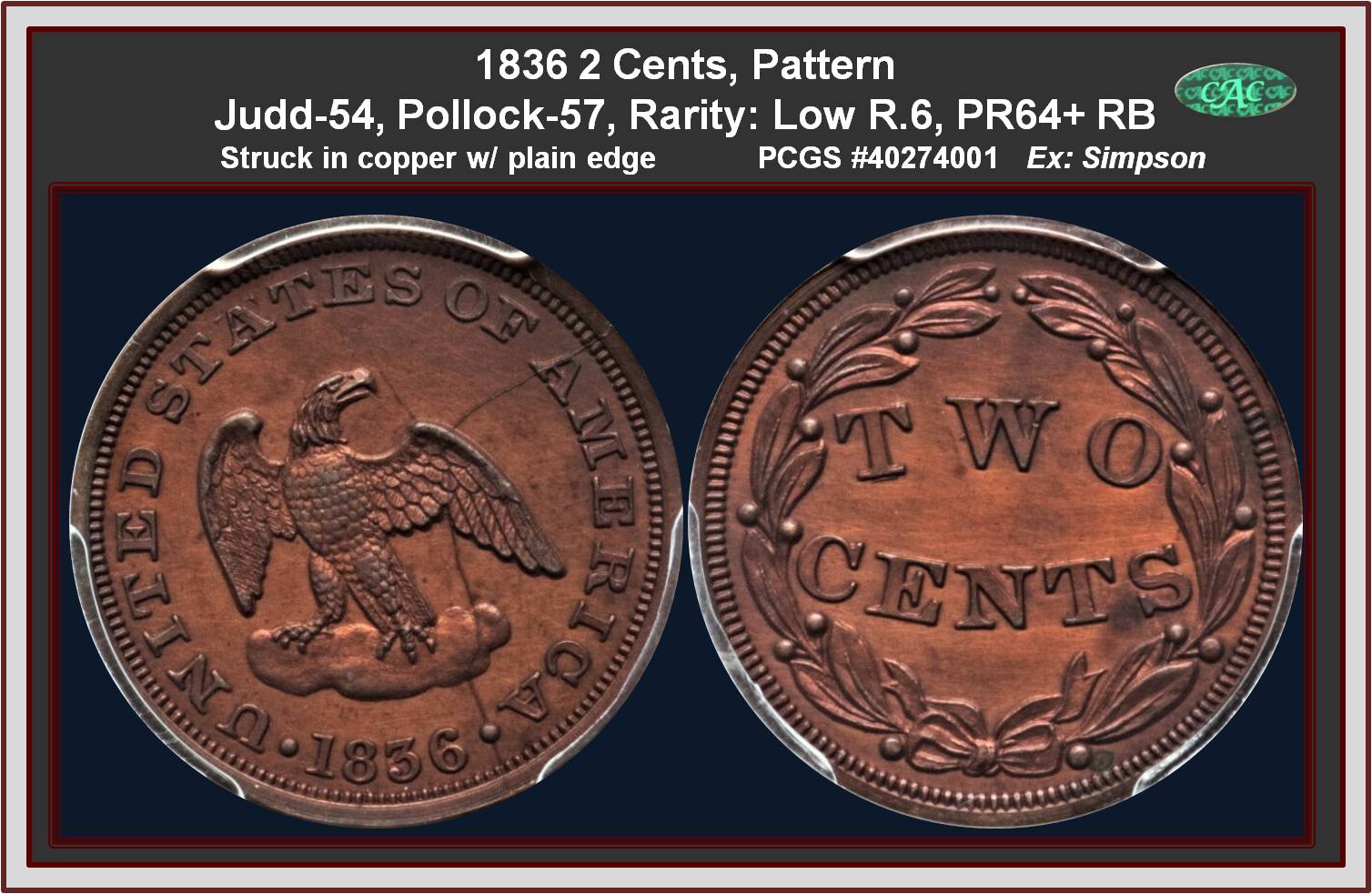
1836 2C
Judd-54, Pollock-57,
Rarity:Low R.6
PR64+ RB CAC Endorsed
Ex: Simpson/Pittman.
Struck in copper with Plain edge
Obverse: Features a standing eagle facing right and perched on a cloud, surrounded by UNITED STATES OF AMERICA and date 1836 separated by two dots. The obverse die shows the A in STATES corrected from an E underneath.
Reverse: Shows the denomination "TWO / CENTS" in arcs surrounded by an olive wreath.
Comment:
59.2 grains
Fiery orange fields contrast nicely against brown devices and lettering. Several blatant engraving errors clearly show, including an E originally cut in place of the Ain STATES, and the 6 first erroneously punched in the 3’s position. Sharply struck with a high wire rim. There are some light hairlines in the fields as well as several spots.
A die break runs in three directions from the eagle's right wing: 1) through the left side of the A to the rim; 2) down through the cloud and the stop between the date and AMERICA to the rim; and 3) from the top of the eagle's wing into the field, past the eagle's beak toward the E in STATES. Struck with dies parallel to each other, i.e. rotated 180 degrees from the normal “coin turn” of U.S. coinage. All of these characteristics indicate that this is a Restrike minted more than 20 years after the date on the coin. An estimated 20-25 examples are known
Provenance / Appearance:
From The Bob Simpson Collection Pt 2, Heritage Nov 2020 Auction /Lot 3096, Priors
Heritage June 2005 Long Beach (From The Western Hill Collection) / Lot #7353 (as NGC65RB);
David Akers Oct 1997 The John Jay Pittman Collection: Part 1 / Lot # 770 ($3080) with Note Prior Purchased by John Pittman for 55$ as Lot 5 from Abe Kosoff’s 1958 ANA Convention sale
|

|
|
View Coin
| J-60 1$ |
United States
|
$1 1836 SILVER GOBRECHT J-60
|
PCGS PF 55
|
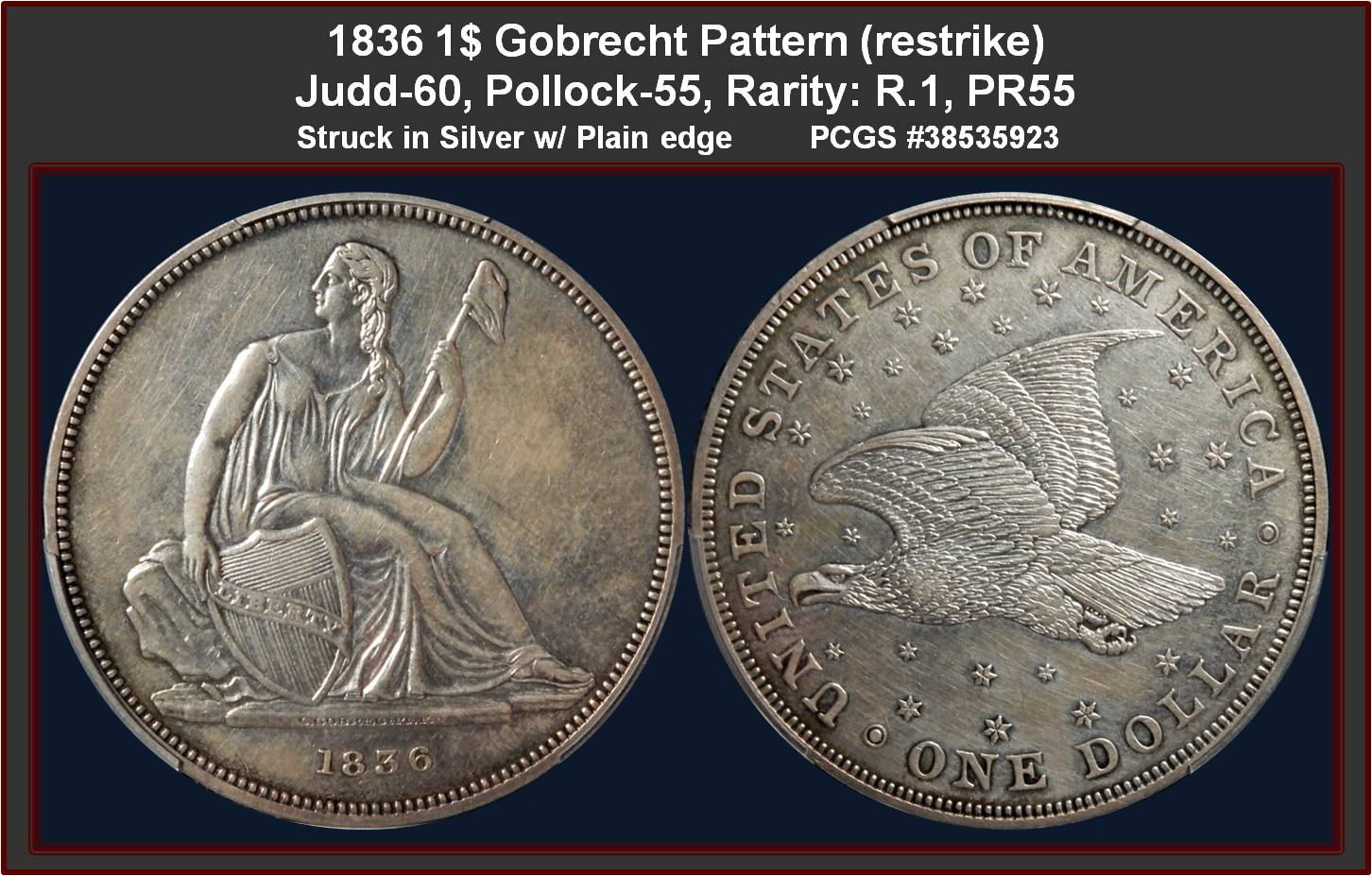
1836 1$
Judd-60, Pollock-55.
Rarity: R.1 Restrike issue.
Struck In Silver with Plain Edge
Obverse: Depicts Liberty seated on a rock holding a pole in her left hand with a cap of freedom perched on top, her right hand supports a shield draped with a ribbon inscribed LIBERTY. The entire obverse is free of legends otherwise, and the only device aside from Lady Liberty is the date below of 1836.
Reverse: There is an eagle in full flight, flying level in a starry field, with small and large stars. Surrounding the stars and eagle is UNITED STATES OF AMERICA / ONE DOLLAR with stops in between the denomination.
Comment: These were the first silver dollars struck for circulation since 1803, and although they were issued in tiny numbers the die was cast and in 1840 this series of silver dollars began production in earnest and these circulated more widely, although the designs were modified.
Christian Gobrecht was the third person to occupy the post of chief engraver at the Philadelphia Mint. His popularity is reflected in such terms used as “Gobrecht dollar” and “The Gobrecht Journal”. Among pattern coins his contributions are at once vital, beautiful, and far-reaching. Most known are his Liberty Seated coins, first made in Pattern form in this 1836 silver dollar, and continued across the denominations of half dime, dime, quarter dollar, half dollar, and silver dollar for years thereafter. Separately, Gobrecht's elegant flying eagle is an American numismatic icon. First used on the 1836 pattern dollar, it later appears on many other Patterns as well as regular issue 1857-1858 cents
This particular coin is quite impressive and desirable An lightly toned example with flashy surfaces and lovely antique silver-gray toning with deeper blue and russet accents surrounding the devices. The surfaces are sweet and smooth, with no detracting marks and the eagle's breast feathers are bold.
Provenance/ Appearance:
From Ira & Lee Goldberg June 2020 Pre-Long Beach Auction /Lot 654
|

|
|
View Coin
| J-70 1$ Gilt |
United States
|
G$1 1836 J-70 GILT
|
PCGS PF 64
|

1836 PG$1 Gold Dollar
Judd-70 Gilt, Pollock-73
Rarity: Low R.7, PR64, CAC Endorsed
Ex: Simpson.
Struck in copper with a plain edge, and gilt
Obverse: The obverse displays a Liberty cap surrounded by a glory of rays with LIBERTY on the band, a motif reminiscent of the various Mexican silver coins of one to eight reales and fractions thereof that appeared in 1824.
Reverse: The reverse shows 1 and D. on two lines enclosed by a graceful palm frond, with the date below and UNITED STATES OF AMERICA around the rim..
Comment: The copper pieces are believed to be restrikes and only a dozen or so are known. This is a bright yellow-gold example that resembles a gold striking, just lacking the depth of mirroring one would see on a proof gold coin.
Dies by Christian Gobrecht, who interrupted his work on the second obverse of the silver dollar to complete these dies. Pieces were struck before March 14, 1836, as a letter of that date from the Mint Director to the Secretary of the Treasury enclosed a specimen in gold. The obverse design with Liberty cap surrounded by rays was directly copied from the series of silver coins struck by the Mexican Republic starting in 1823. Gobrecht had used the same design a few months before on his mint medals dated Feb. 22 and March 23, 1836 for the first steam coinage at Philadelphia (Qulian MT-20,21). Nearly the same designs (obverse and reverse) were used again in 1850 on a silver trime pattern (J-125), with the date moved to the obverse
Provenance/Appearances:
Ex: Bob Simpson, Heritage May 2022 CSNS/ Lot #3628; ; Prior
- Paramount Apr 1981 (Sutherland Collection) /Lot #2;
- Bowers & Merena Feb 1987 / Lot 2267
Video Link by Heritage on J-70 Not my specific coin but similar
|

|
|
View Coin
| J-72 50C |
United States
|
50C 1838 J-72
|
NGC PF 60
|

1838 50C
Judd-72, Pollock-75, (possible a restrike)
Rarity: R.5,
Struck in silver with a reeded edge and medal turn.
Obverse: A large bust of Liberty faces left, with 13 stars around and the date is below the bust. Miss Liberty is wearing a diahem and LIBERTY is inscribed on a ribbon.
Reverse: Features an eagle with spread wings holding an olive branch and her right talon is holding arrows. UNITED STATES OF AMERICA and the denomination are around the perimeter.
Comment: The obverse design is traditionally attributed to William Kneass, but Gobrecht was likely the engraver, since the portrait closely resembles the gold eagle also introduced in 1838.
A nicely struck specimen with pearl-gray and wheat-gold toning. The surfaces are slightly subdued and the left obverse field exhibits a few faded marks. An obverse planchet flaw near 9 o'clock is as made
Provenance / Appearance:
Heritage June 2014 - Long Beach / Lot #5531
|

|
|
View Coin
| J-73
50c Bust Left - Gobrecht Liberty Head / Flying Eagle reverse
|
United States
|
50C 1838 J-73
|
NGC PF 63
|
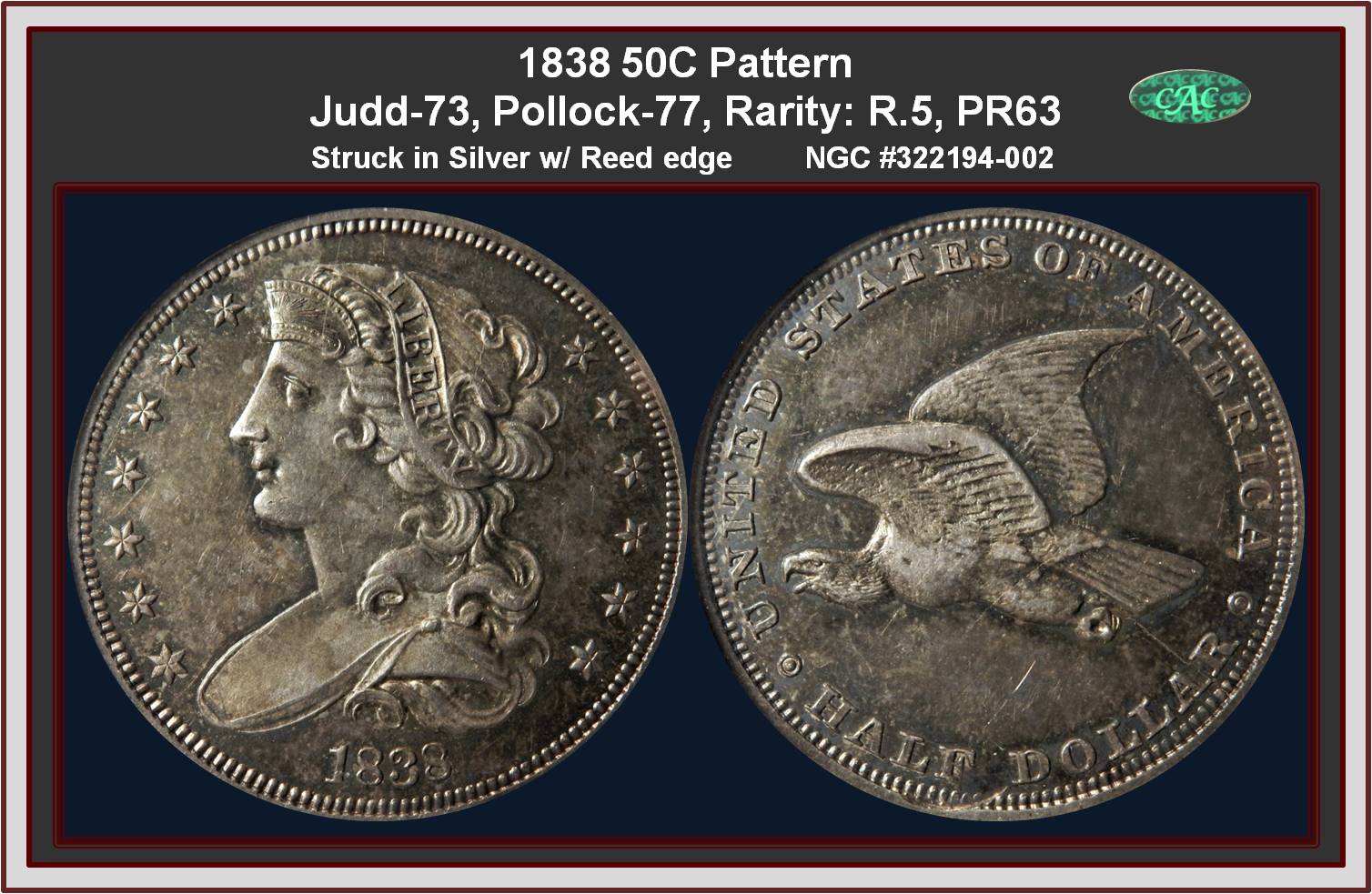
1838 50C
Judd-73,Pollock-77,
Rarity: R.5, PR63 CAC Endorsed
Struck in silver with a reeded edge
Obverse: Same as J-72, A large bust of Liberty faces left, with 13 stars around and the date is below the bust. Miss Liberty is wearing a diahem and LIBERTY is inscribed on a ribbon.
Reverse: A flying eagle facing Left with United Staes above and "HALF DOLLAR" below. The eagle may have been copied by Gobrecht from the Titian Peale sketch. 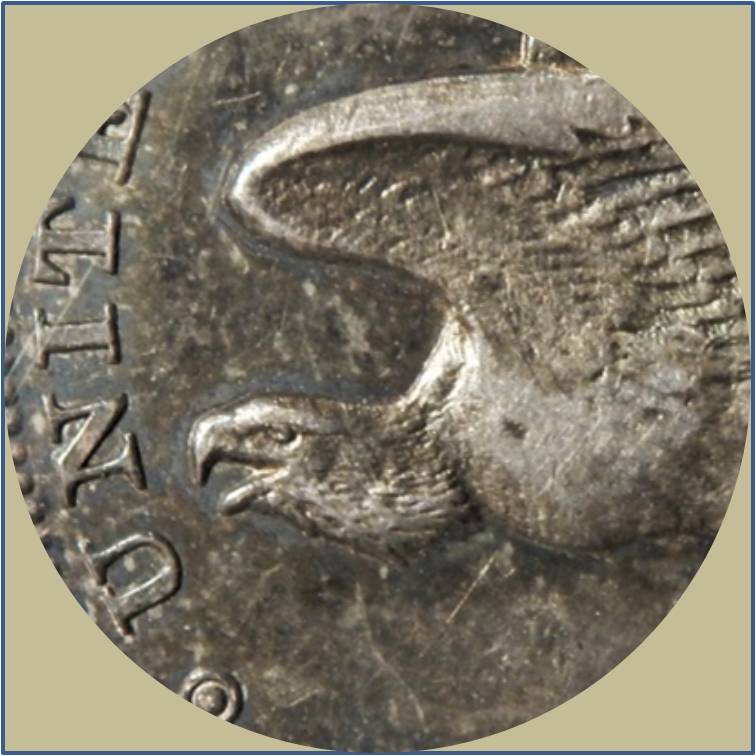
Comment: Interesting to note the mouth of the eagle is open and Pollack III reference book shares the exchange between Treasury Woodbury and Mint Director Patterson about trying work it to have the Eagle mouth close.
This example is better struck than usual for a Judd-73, though the eagle's breast are incompletely brought up. Attractively toned in powder-tan, olive-green, and peach-gold shades and nice mirrors
provenance/ Appearances:
Greats Collections Oct 2016
|

|
|
View Coin
| J-77 50C |
United States
|
50C 1838 J-77
|
PCGS PF 63 Red Brown
|

1838 50C (In Copper)
Judd-77 Restrike, Pollock-85
Rarity: High R.7 PR63 RB
EX Farouk/ Turoff
Struck in copper with a plain edge.
Obverse: Features the regular issue No Drapery Liberty Seated design
Reverse: A heraldic eagle holding an olive branch in its right talon and four arrows in its left is in the center and is similar to the two cent patterns from 1836.
Comment:
The restrike status of this piece is clearly seen by the extensive die rust on the reverse. The surfaces have an underlying bright, cherry-red color from an old cleaning that has since toned over to a great extent. Apparently only four pieces are known of this elusive pattern.
Specific characteristics prior to being slab is 150.8 grains. Diameter: 1.193 inches. Die alignment: about 10°.
Provenance/Appearances:
- Ex: Farouk Sale (Sotheby's, 1954), lot 1726;
- Cox Collection (Stack's, 4/62), lot 2191;
- Whitney Sunderland / Julius Turoff (Bowers and Merena, 3/1994), lot 1436;
- Superior May 1995 / Lot 3495 & Again Superior Jan 1996 Piedmont sale / Lot 1222 ( Not sold);
- Heritage Aug 1996 (ANA) / Lot 5069 & Heritage Mar 1997 (ANA) /Lot 6559 (Not Sold)
- Heritage Mar 2000 Central States Signature auction / Lot #7958.
- More recently from The Collection of William Rau Heritage April 2018 CSNS - Chicago / Lot #4482,
- Heritage Jan 2020 FUN / Lot #5855
|

|
|
View Coin
| J-119
One Cent: Small annular cent w/hole in the middle |
United States
|
1C 1850 J-119
|
PCGS PF 63
|

1850 1C
J-119 Original, Pollock-134
Rarity: Low R.6 PR63
Struck in billon (10% silver, 90% copper) with a plain edge and medal turn.
The annular cent pattern, with a largish hole in the middle. It is interesting to note that Judd describes the obverse in the convention manner, as the side with the date, while Pollock reverse the sides.
Obverse: displays the denomination CENT at the top, the date 1850 is at the bottom, two rosettes are on each side, and a perforation in the center. It is interesting to note that Judd describes the obverse in the convention manner, as the side with the date, while Pollock reverse the sides.
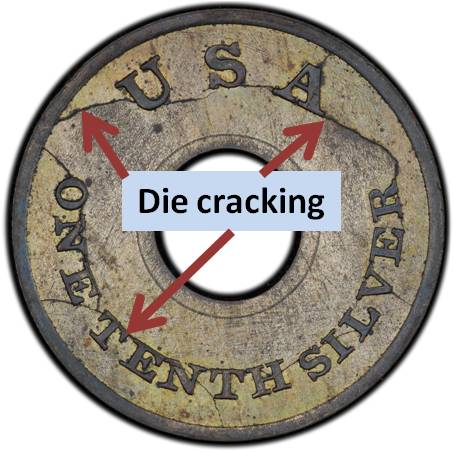 Reverse: USA inscribe at the top and "ONE TENTH SILVER" around at the bottom. It is curious the the U is not parallel to the rim on the inscription of USA. In the striking process of shattering and this piece shows the heavy die cracks that resulted. Reverse: USA inscribe at the top and "ONE TENTH SILVER" around at the bottom. It is curious the the U is not parallel to the rim on the inscription of USA. In the striking process of shattering and this piece shows the heavy die cracks that resulted.
Comment: Gray patina is seen over each side with bright, underlying silver-rose surfaces. A lovely example
With this pattern the Mint thought that a copper cent with a trace of silver, and in small diameter, could be produced to yield a profit. A problem with billon, was that the users of such coins had no way to notice the silver alloy, making them easy to counterfeit cheaply. Further, the making "holey" coins was a clumsy procedure.
Moreover, several years later on May 26, 1854, James Ross Snowden, then director of the Mint (since 1853), wrote to Secretary of the Treasury James Guthrie, noting that when eventually such billon pieces were redeemed after use, the cost of recovering the silver would exceed the value the silver metal obtained. Further: "The mechanical difficulties in making ring cents are not trivial. They lie not in planchet cutting but in stamping in ejecting the coin from the dies. I estimate that most of the value of a cent so formed would be sunk in the cost of striking."
Provenance/ Appearances:
Heritage Oct 2016 - Dallas / Lot #3963
|

|
|
View Coin
| J-124
One Cent: Small annular cent (Center Not Punched) |
United States
|
1C 1850 J-124
|
PCGS PF 64
|
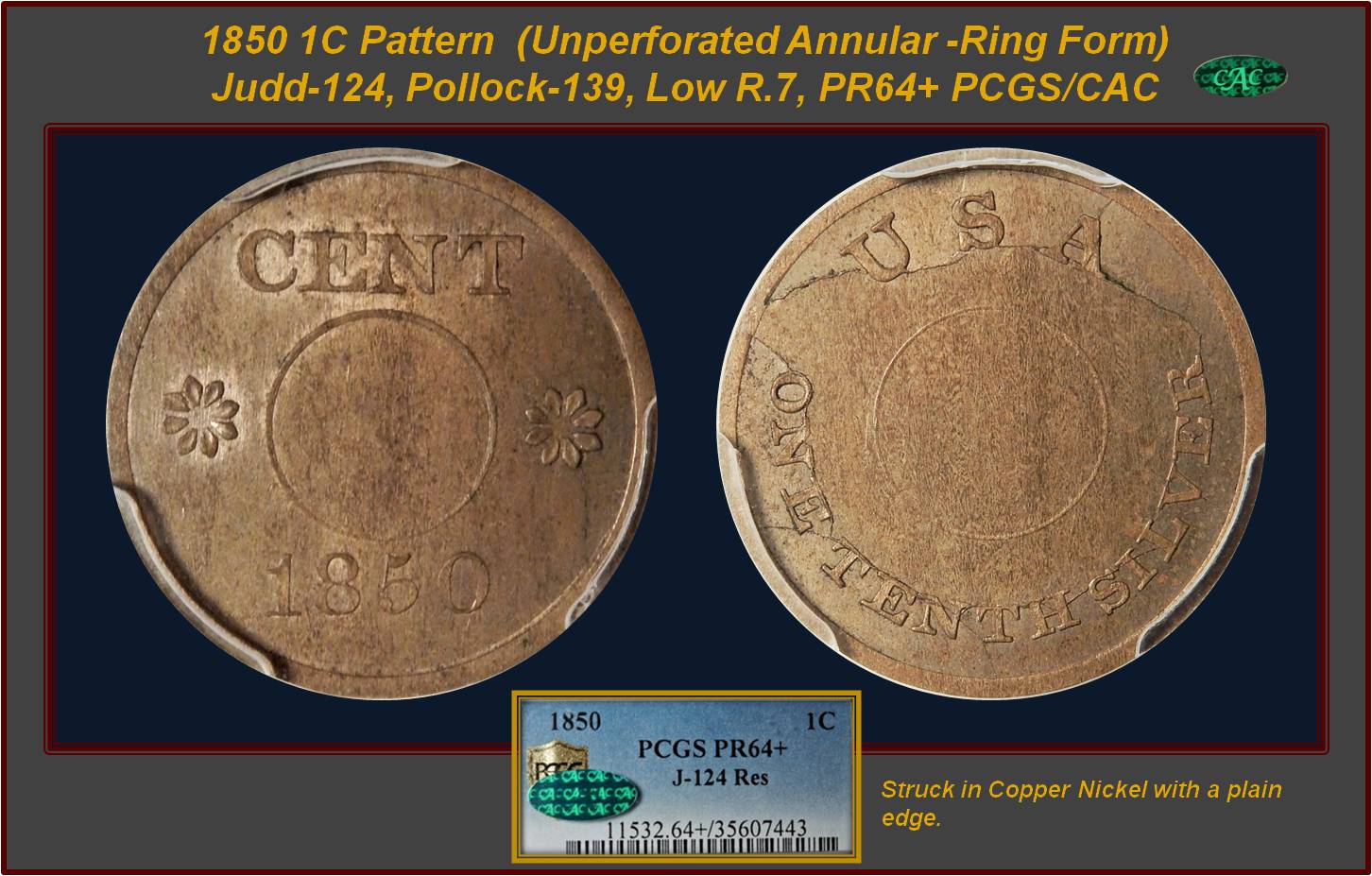
1850 P1C One Cent
Judd-124 Restrike, Pollock-139 --- same as the J-119 but without the perforation.
Rarity: Low R.7, PR64 + CAC Endorsed
Ex: Lumus
Struck in copper-nickel with a plain edge
Obverse: : CENT above place for undrilled hole, 1850 is beneath, floret are to either side of the unpunched hole.
Reverse: “USA” arcs above space for undrilled hole, and “ONE TENTH SILVER” curves below. Extensive die breaks on the reverse.
Comment: An experiment in producing a smaller-size cent piece, one intended, of course, to be produced in silver with a central perforation to lower the weight and corresponding silver content. The originals were produced in billon (90% copper, 10% silver), with weights from 24 to 26 grains, but they were too subject to counterfeiting, among other difficulties with the issue.
indicate the
The piece is is a Light gray-rose color covering both sides, with some minor flecks noted on both sides but nonetheless attractive. The reverse (ONE TENTH SILVER) side shows extensive peripheral die breaking through the legends. The die apparently shattered early during the striking of the original restrike status of this piece, of which only a half dozen or so are known.
Provenance/Appearance:
Private sale June 2019; Prior
|

|
|
View Coin
| J-125
3 Cent - Liberty Cap Trime |
United States
|
3CS 1850 J-125
|
PCGS PF 63
|
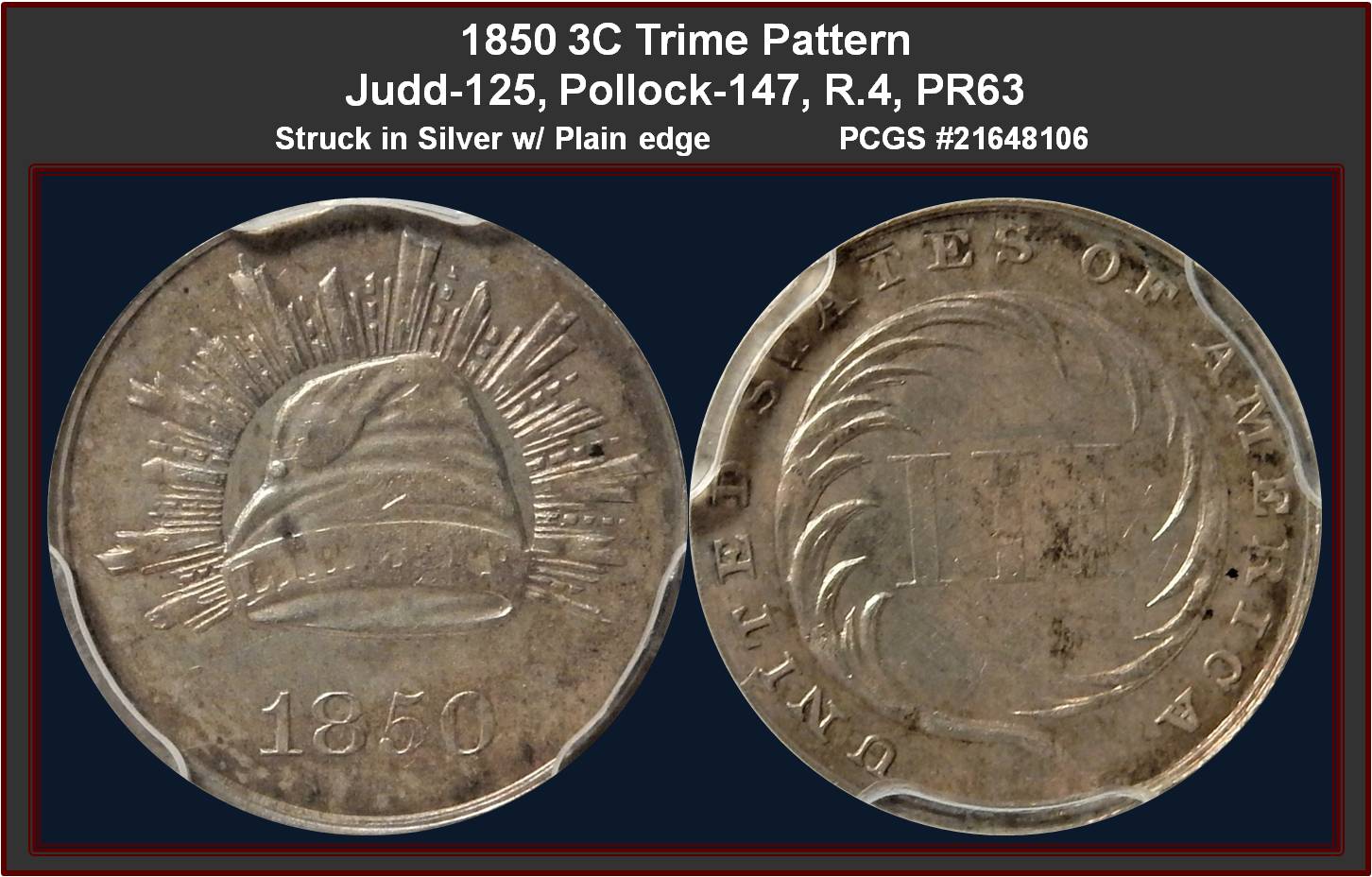
1850 3 Cent Silver
Judd-125, Pollock-147.
Rarity: R.4 .
Struck in silver with a plain edge
Obverse: Exhibits a liberty cap surrounded by a glory of rays with the date 1850 below. The word LIBERTY is inscribed on the band of the cap.
Reverse: A coiled palm frond encircles a Roman numeral III with the legend UNITED STATES OF AMERICA around the border.
Comment: An attractive design that artist Franklin Peale borrowed from Christian Gobrecht’s 1836 gold dollar pattern. James Barton Longacre prepared designs for this denomination in 1850. The dies for this pattern issue were prepared by Franklin Peale and were ready early in 1851. Obviously, the Longacre designs were preferred, since they were chosen for the final issue prepared for circulation
This diminutive pattern is subtly reflective with golden-violet toning that gathers strength at the margins. The centers are softly brought up and retain some of the planchet's rough texture. The Pollock reference records significant variance in planchet weights. Its strike suggests the present piece was coined from lighter stock.
Provenance/Appearances:
From Stacks March 2011 Baltimore Auction /Lot #6002; Prior
- Golberg Feb 2009 Pre Long Beach Lot #1322,
- Heritage Oct 2006 Dallas Signature Auction / Lot #2361;
- Heritage Aug 2004 Pittsburgh Signature Sale/ Lot #7874
|

|
|
View Coin
| J-127
One Cent: Small annular cent w/hole in the middle (Undated) |
United States
|
1C (1851) J-127
|
PCGS MS 64
|

(1851) ONE TENTH
Judd-127 Original, Pollock-149,
Rarity: Low R.6; MS64
Struck in billon (10% silver, 90% copper) with a plain edge.
Obverse: Features CENT at the top and ONE TENTH SILVER at the bottom, Struck in 1851 these pieces are dateless
Reverse: Reverse depicts a laurel wreath and the legend UNITED STATES OF AMERICA.
Comment
Part of an effort to reduce the diameter of the cumbersome large cent but these were most likely struck just to test the materials as perforations was abandon in the prior year. This piece is center perforated, unlike restrikes.
The surfaces are hazy gray and there is a planchet lamination across much of the obverse. Sharply defined and otherwise well struck. Billion must be difficult to classify as Proof but no articles indicated a "Business Strike" for the J-127 even though PCGS has slabbed a couple J-127's as MS vs a proof designation
Provenance/ Appearances:
Heritage Aug 2017 ANA Auction - Denver / Lot #5393
|

|
|
View Coin
| J-140
1$ Gold Ring |
United States
|
G$1 1852 J-140
|
PCGS PF 64
|

1852 G$1 Annular Dollar in Copper-Nickel
Judd-140, Pollock-167
Rarity: Low R.7 PR64
Struck in copper-nickel with a plain edge.
Obverse: Only USA above the hole with 1852 below,
Reverse: A series of laurel sprigs amidst heavy concentric die lines. Curiously, no denomination is stated.
Comment:
One of the proposed solutions to the problem of the undersized and easily lost gold dollar was an annular pattern. The large center perforation (as struck) and narrow margin forces a simple design. Curiously, no denomination is stated.
The surfaces have toned a light brown but still retain the distinctive underlying golden-tan color common to copper-nickel alloy. Original, untampered surfaces with a couple of small, dark incrustations on each side.
Provenance/Appearance:
Private sale Jan 2019; Prior Heritage June 2017 Long Beach Expo Auction / Lot #4021
|

|
|
View Coin
| J-148
1$ Gold Ring |
United States
|
G$1 1852 J-148
|
NGC PF 65
|
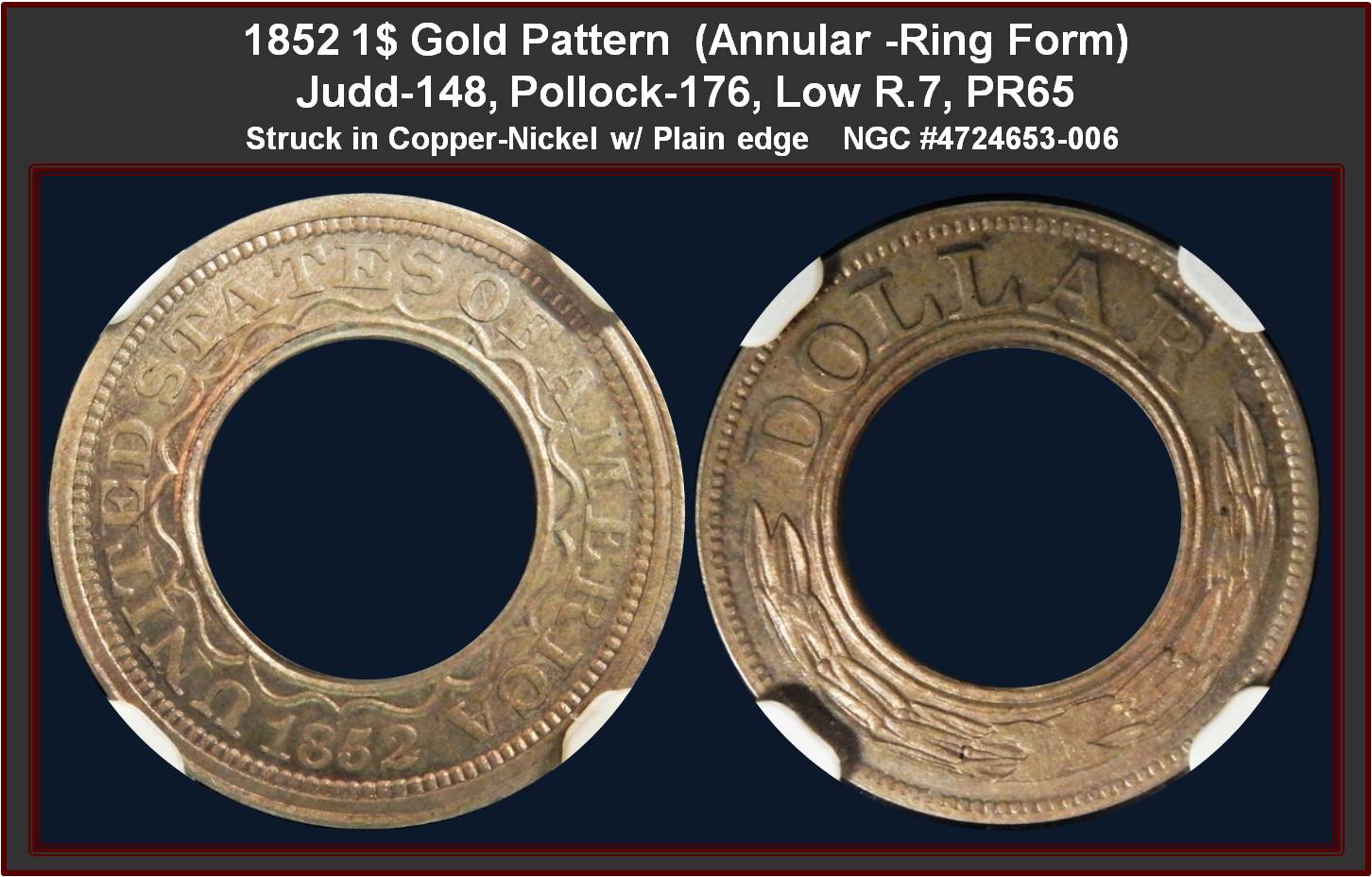
1852 G1$ Annular, or Ring-Form Pattern Gold Dollar
Judd-148, Pollock-176
Rarity: Low R.7 PR65
Annular gold dollar. Struck in copper-nickel with a plain edge.
Obverse: Annular gold dollar with perforation and UNITED STATES OF AMERICA and 1852 around ornamented raised rim.
Reverse: the simple wording for denomination "DOLLAR" and a wreath around a raised rim.
Comment:
A very interesting concept for the gold dollar. Starting in 1849 with the mass outpouring of gold from California, gold dollars were struck, but were tiny. In an effort to make the diameter larger and still maintain the legislated weight, a larger planchet was produced with a perforated hole in the center punched out
With the vast quantity of gold coins in circulation as a result to the California Gold Rush, the value of silver rose in relation to the price of gold, and silver began to disappear from circulation, particularly the silver dollar. As a result, many gold dollars were struck during these years where the silver dollar mintage dropped. The gold dollar as it was minted was small, and in an effort to enlarge the diameter of the denomination, the Mint experimented with these annular or ring shaped designs. Pollock designates the Judd-148 as "Probably a restrike," and notes that "thick and thin planchet varieties exist, per the Adam
Provenance/Appearance:
Private sale June 2019. Could not locate prior appearance
|

|
|
View Coin
| J-151
One Cent: Liberty Bust Small Cent |
United States
|
1C 1853 J-151
|
PCGS PF 62
|

1853 E1C One Cent
Judd-151, Pollock-178
Rarity: Low R.6, PR62 CAC Endorsed
Struck in Copper Nickel ( believed 40% Nickel / 60% copper) with Reeded Edge
Obverse: Liberty Head with 13 stars - same as regular issue 1853 Quarter Eagle
Reverse: The denomination of "One Cent" within a laurel wreath.
Comment:
This pattern issue combines the obverse of 1853 quarter eagles with a new reverse inscribed ONE CENT. Composition was copper-nickel alloy similar to the “German silver” alloy used by Lewis Feuchtwanger for his private cent patterns of 1837. This alloy combined copper, nickel, and zinc in various proportions.
Three such compositions were recorded:
40% copper, 40% nickel, 20% zinc;
30% nickel, 60% copper, 10% zinc; and
40% nickel, 60% copper.
Although each composition had its own inherent coloration, practical considerations suggest these cannot easily be distinguished by color alone. Specific gravity of these compositions do not provide the necessary distinction.
This piece is a lovely Pewter gray, with light striated toning visible on both sides. Some underlying reflectivity in the fields. A scratch is noted along Liberty's throat, but is not likely to be noticed without magnification.
Provenance/Appearances:
Purchased from Park Avenue Mar 2015; From the 1853 Collection. Stacks and Bowers Oct 2014 Winter Baltimore Sale/ Lot #1058, Prior Purchased privately from South Miami Rare Coins, Feb 1991.
|

|
|
View Coin
| J-159a
One Cent: Small Seated Liberty |
United States
|
1C 1854 J-159a
|
PCGS PF 64 Brown
|
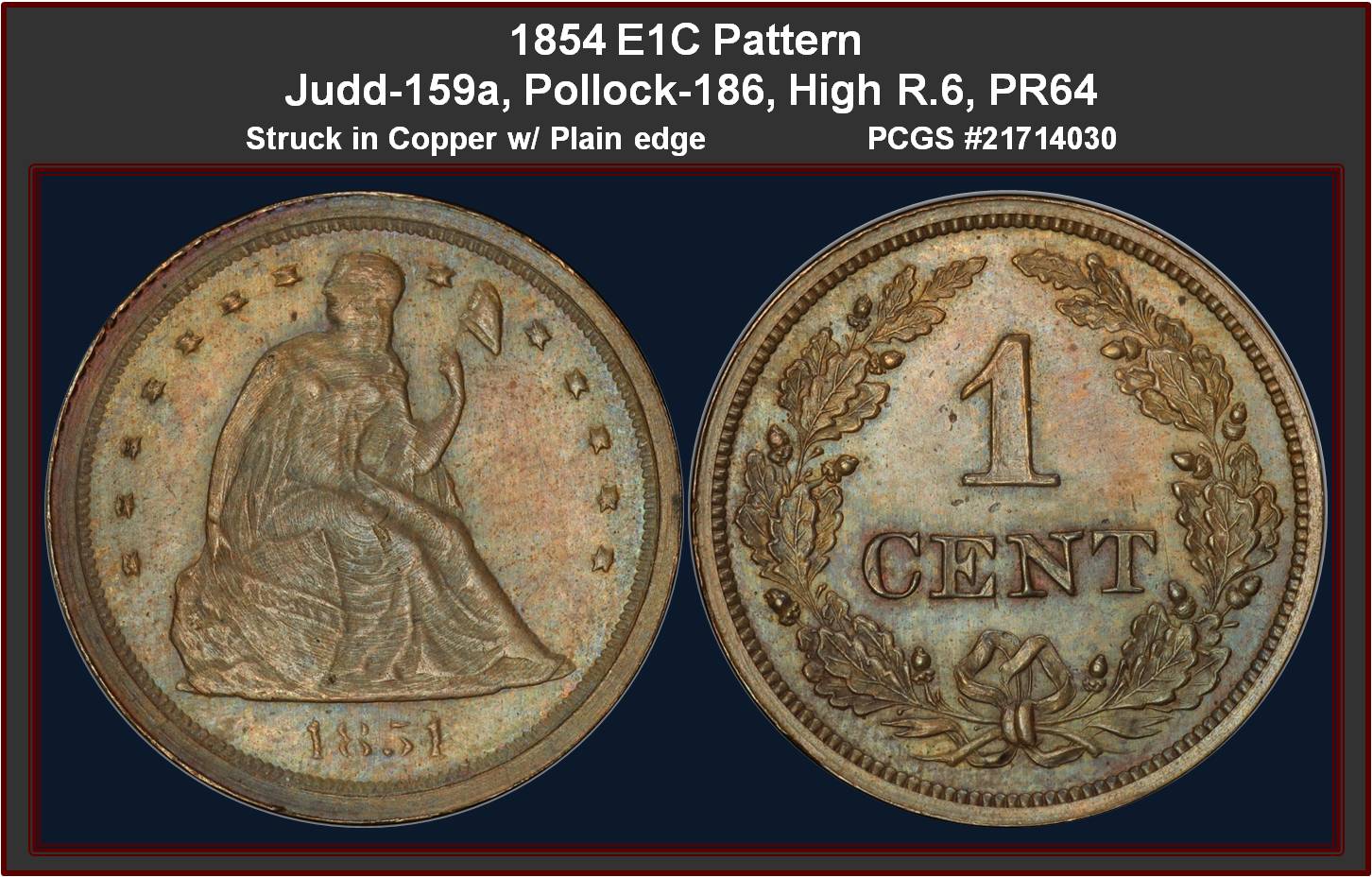
1854 1C
Judd-159a, Pollock-186,
Rarity: High R.6, PF64
Struck in copper with a plain edge.
Obverse: Gobrecht's Liberty Seated motif, as seen on the circulating silver issues of the era, 13 thin, attenuated stars around Liberty, date below.
Reverse: 1 CENT within open-topped wreath of oak leaves and acorns, bow at bottom of wreath.
Comment: An unusual pattern variety. The obverse die was made by crudely reducing an 1854 silver dollar with a lathe, causing prominent concentric die lines and blurry design details. The date resembles 1851. The reverse shows 1 CENT encircled by an oak and acorn wreath. The while the die struck Judd-159 is a formidable rarity (two or three known) but its electrotype copper counterpart Judd-159a is somewhat more available but not by much with only 13 - 20 pieces believed to exist. 
The original holder the edge was obscured by the encapsulation, which made it impossible to confirm the seam that distinguishes Judd-159a from Judd-159 was there. After having it re-holder PCGS confirmed it was a Judd-159. It was not until the 8th Edition of Judd reference book that the 2 different varieties were separated. Both sides exhibit a wire rim, especially steep on the obverse near 11 o'clock.
A sea-green and tan-brown near-Gem with a few tiny flan flaws on the central reverse.
Provenance/Appearances:
From The Tom & Jean Fore Collection. Heritage Jan 2016 - Tampa / Lot #6272;
Prior
- Dallas Signature (Heritage, 12/2004), lot 6346;
- Heritage Jan 29, 2005 Continuous Internet Auction / Lot #23425;
- Sherman's Obsessive Compulsive Collection, Stacks June 2010 Baltimore / Lot 3396;
- Stacks August 2011 Chicago ANA / Lot 9003;
|

|
|
View Coin
| J-160
One Cent: Large- Braided Hair
Copper |
United States
|
1C 1854 J-160
|
PCGS PF 64 Brown
|

1854 1C
Judd-160, Pollock-187
Rarity: R.4; PF64BN
From the Lux Family Collection, begun as early as the 1850s.
Struck in Copper with Plain Edge
Obverse: : The usual head of Liberty facing left from the contemporary large cent design, with the date below. No other design elements are present, so the effect is a pleasing cameo. The diameter is slightly smaller than the contemporary regular issue large cent.
Reverse: : An exact copy of the current large cent, however the design elements are not only smaller for the reduced size of the coin, but the size of the lettering and wreath are also smaller, producing a more elegant ensemble. Thus the wreath is compact and the letters are more finely executed.
Comment: : This is an attractive Choice specimen that exhibits dominant medium brown patina with glints of original faded orange luster persisting, more so on the reverse than the obverse. Sharply struck overall and pleasingly smooth.
Provenance/Appearances: :
Stacks and Bowers March 2021 Auction - Session 5 / Lot 5596; From the Lux Family Collection, that began as early as the 1850s.
|

|
|
View Coin
| J-161
One Cent: Large- Braided Hair
Bronzed |
United States
|
1C 1854 J-161
|
PCGS PF 63 Brown
|

1854 1C
Judd-161, Pollock-187
Rarity: R.4 Original; PF63BN
Struck in Bronze with Plain Edge
Obverse: : The usual head of Liberty facing left from the contemporary large cent design, with the date below. No other design elements are present, so the effect is a pleasing cameo. The diameter is slightly smaller than the contemporary regular issue large cent.
Reverse: An exact copy of the current large cent, however the design elements are not only smaller for the reduced size of the coin, but the size of the lettering and wreath are also smaller, producing a more elegant ensemble. Thus the wreath is compact and the letters are more finely executed.
Comments:
Lovely struck large Cent with nice bright brown surfaces.
This design the same as the J-160 above - Pollock did not assign a unique reference number between these Judd samples as he believed you can not distinguish without a metallurgic testing.
Provenance/Appearances: :
From ANA Money Show 2005 Atlanta, Prior Heritage Aug 2004 - Pittsburgh, PA Signature Sale / Lot #7880
|

|
|
View Coin
| J-164
One Cent: Large- Flying Eagle |
United States
|
1C 1854 J-164
|
PCGS PF 65 Brown
|

1854 1C Flying Eagle
Judd-164 Original, Pollock-189
Rarity: R.5, PR65 BN
Struck in bronze with a plain edge.
Obverse: Flying Eagle design with a hook-neck eagle on the obverse, surrounded by stars and the date below.
Reverse: Closely resembles the regular dies issue for the large cent. A continuous wreath with ribbon at bottom. 2 leaves at under the E (of States). 2 other rarer reveres varieties exists with different # of Leaves
Comments:
US patterns.com states that Originals are said to be from 90 to 100 grains with re-strikes weighing about 113 grains.
A pleasing wood grain effect is noted on the obverse, while uniform chocolate-brown color prevails on the reverse.
Provenance/Appearance:
Private sale with Ric Snow; Prior Heritage Spt 2016 Long Beach Signature Auction / Lot #5866; Heritage Feb 2002 Long Beach Signature Auction/ Lot #7270
|

|
|
View Coin
| J-168
One Cent: Large- Flying Eagle |
United States
|
1C 1855 J-168
|
NGC PF 61 BN
|
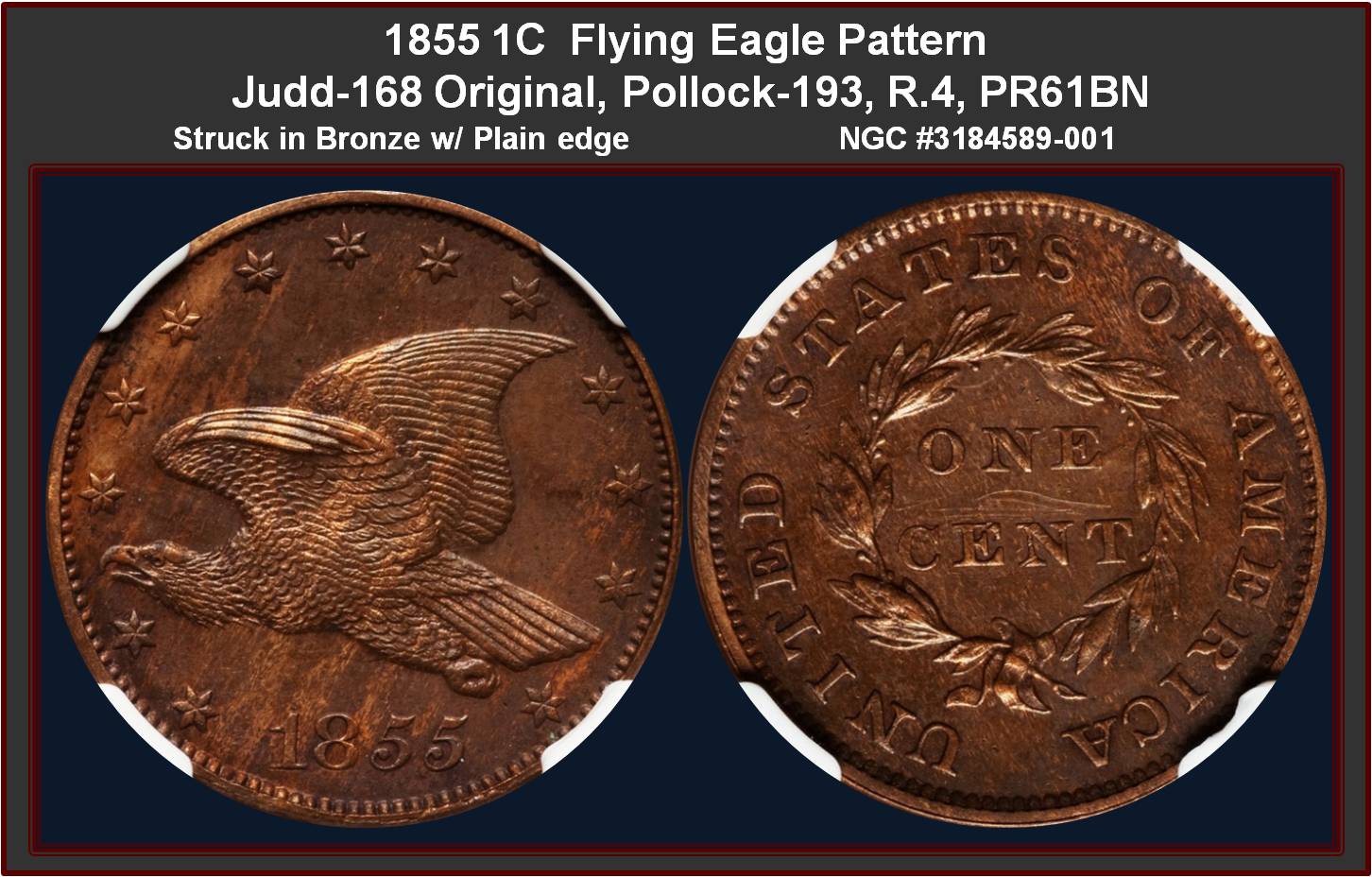
1855 1C Large Cent Flying Eagle
Judd-168, Pollock-193
Rarity: R.4; PF61BN
Struck in bronze with a plain edge.
Obverse: The large cent version of the flying eagle was designed with 13 stars surround an eagle.
Reverse: Similar to the 1855 large cent. The diameter is smaller than the large cents but larger than the small flying eagles that were officially adopted in 1857.
Comment:
This coin is similar to the Christian Gobrecht/Titian Peale flying eagle design for the Gobrecht dollars (and soon the Flying Eagle cents).
The planchet shows streaks ( actually attractive), as often seen on this pattern. A few pin scratches are seen between ONE and CENT on the reverse.
Provenance/Appearances:
Heritage Oct 2011 Signature Auction- Pittsburgh / Lot #4543
|

|
|
View Coin
| J-170a 1C
Large Flying Eagle |
United States
|
1C 1855 J-170a
|
PCGS PF 64
|
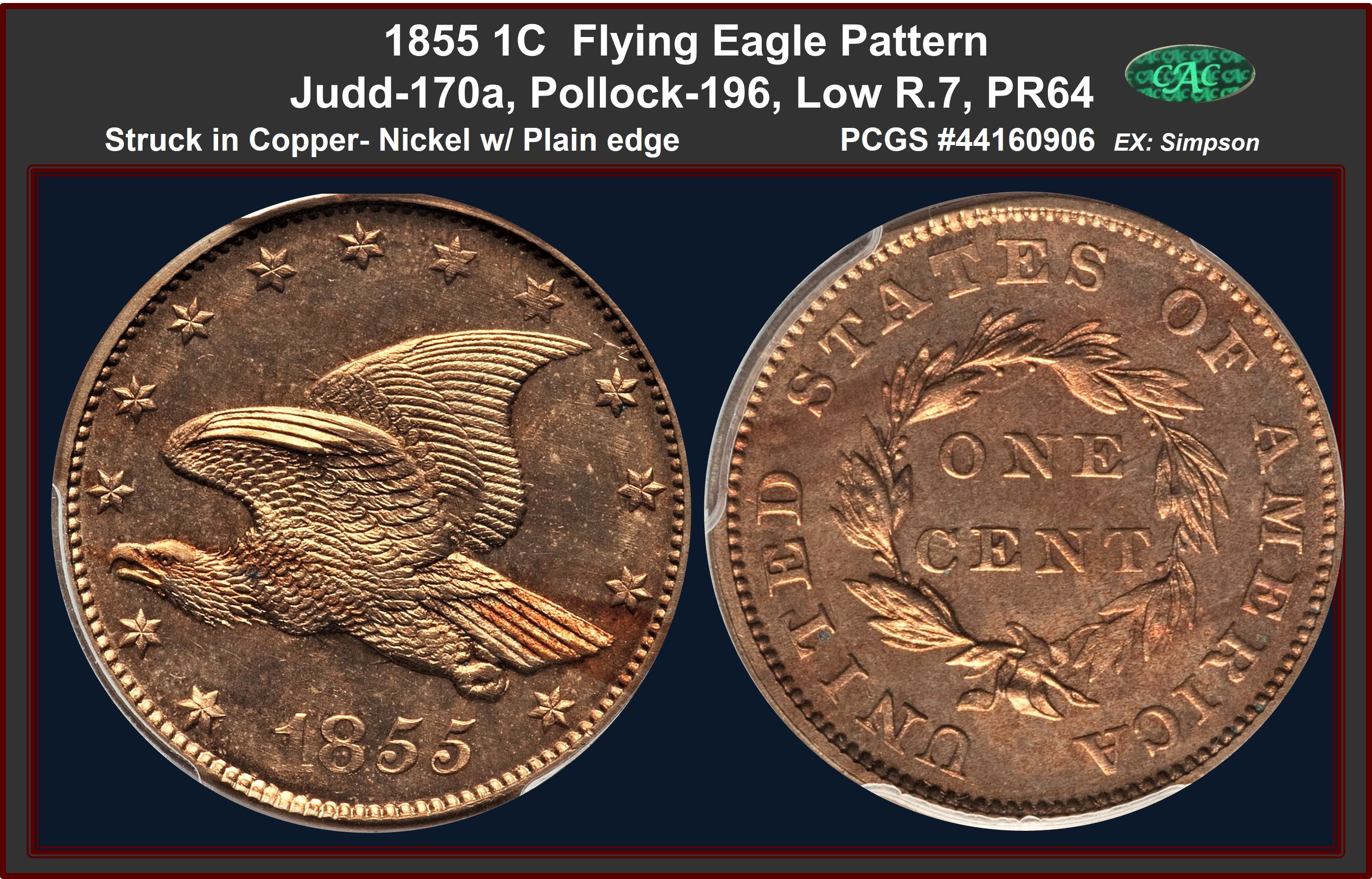
1855 1C Flying Eagle Cent,
Judd-170a, Pollock-196
Rarity: Low R.7, PR64 CAC Endorsed
Ex: Simpson.
Struck in copper-nickel with a plain edge.
Obverse: Thirteen stars surround an eagle that is flying slightly upward, similar to the Christian Gobrecht/Titian Peale flying eagle design for the Gobrecht dollars (and soon the Flying Eagle cents). ‘
Reverse: The reverse design is similar to the issued large cent.
Comment:
 The diameter is intermediate between the large cents struck for commerce in 1855 and the small cents that were first produced in 1856 These still represent a still-to-be-discovered metallurgical variants. The major variants include copper/bronze, oroide, various compositions of copper-nickel, German silver, and pure nickel. The diameter is intermediate between the large cents struck for commerce in 1855 and the small cents that were first produced in 1856 These still represent a still-to-be-discovered metallurgical variants. The major variants include copper/bronze, oroide, various compositions of copper-nickel, German silver, and pure nickel.
The surfaces of this piece display the expected bright yellow-tan appearance of the nickel alloy with occasional streaks of red on each side.
Is is believed to be Copper-nickel 90% copper and 10% nickel
This piece was also the Plate coin image included in the article by Rick King in the April 23, 2023 The Numismatist
magazine on the subject of the mints experimentation with different metal compositions.
Provenance/ Appearances:
Ex Simpson, Heritage May 2022 CSNS / Lot #3633
|

|
|
View Coin
| J-177
Half Cent (1/2C) |
United States
|
1/2C 1856 J-177
|
PCGS MS 63
|
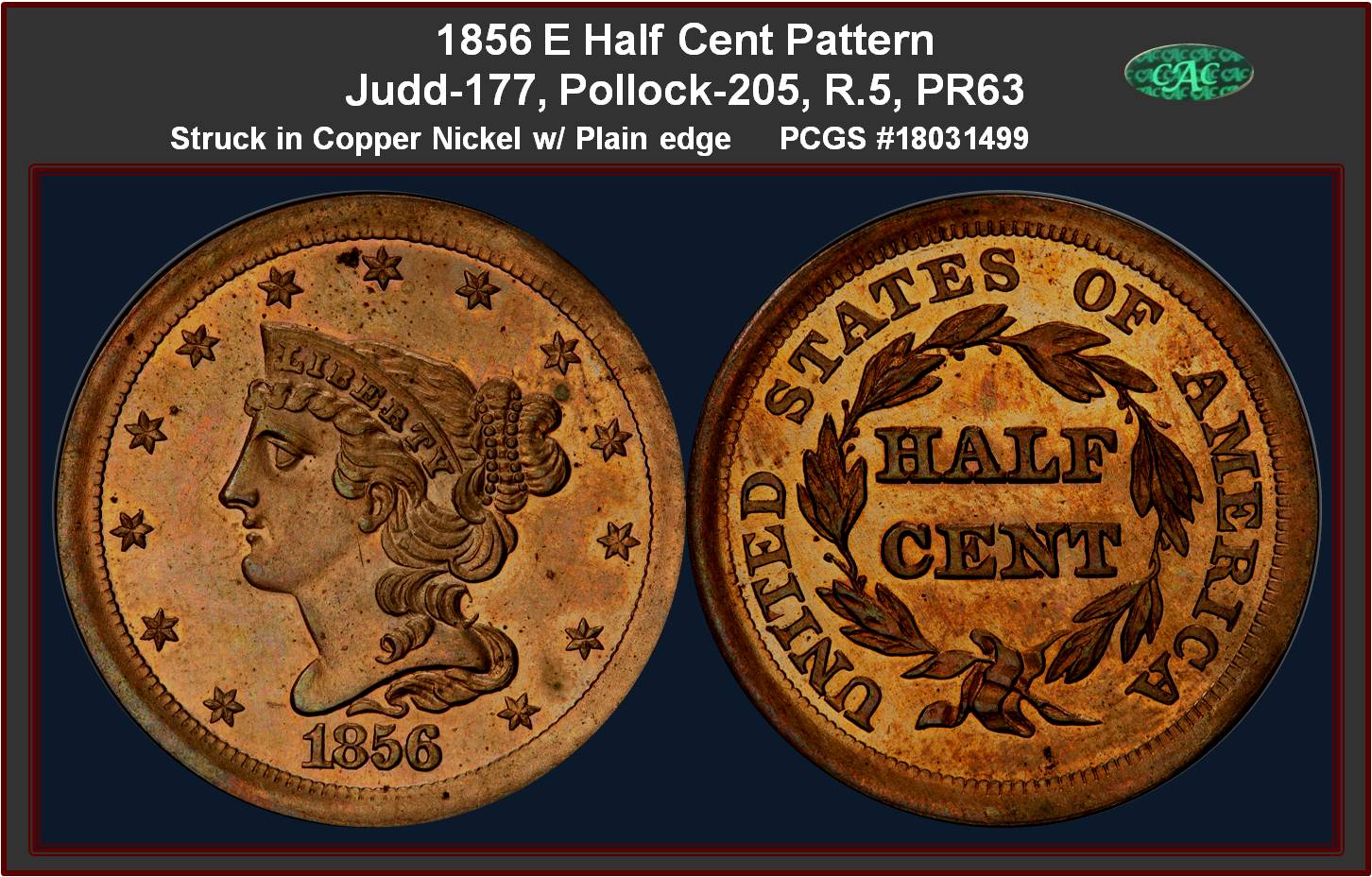
1856 Half Cent
Judd-177, Pollock-205
Rarity: R.5, PR63 Endorsed by CAC.
Struck in copper-nickel with a plain edge.
Obverse/Reverse: Regular dies for the Braided Hair half cent,
Comment:
These metallurgical trial strikes were produced in anticipation of the Flying Eagle small cents that began production the same year.
This example is a lovely Select proof with lightly mirrored, golden-tan surfaces. A few hairlines and contact marks are insignificant.
Additional Information noted the Harry Bass site on these 1/2 cents:
"Essentially an experimental issue to test the copper-nickel alloy, this pattern was struck from the regular dies catalogued as Breen-2 among half cents of this year. Two different compositions are reported, one with 90% copper and 10% nickel, the other with 88% copper and 12% nickel. Although some numismatists have attempted to distinguish between these compositions based on color, the only way to be certain is through elemental analysis. These half cent patterns were struck sometime prior to July 11, 1856, the date of a letter from the Mint Director to Secretary of the Treasury James Guthrie."
Additional Information noted the Stacks and Bowers Catalog notation in the Nov 2010 75th Anniversary Sale
The increase in Nickel usage was partly driven by Joseph Wharton who was a wise businessman who saw an opportunity of mining. The metal nickel was of little use at the time, and he purchased the nickel mines then existing in the Western hemisphere. Soon Wharton had the ears of important politicians and nickel soon became a metal of design for the mint to use. The hardness of nickel meant that it lasted a very long time in circulation; however, the dies were scarcely able to strike it up without shattering. By combining nickel with copper or other metals, the mints were able to employ it as a planchet ingredient on several small denomination coins. Wharton eventually became rich selling his nickel supplies to the mints for coinage and donated money to form the Wharton Business school located at the University of Pennsylvania
Provenance/Appearances
From The Dale Hopkins Collection; 2014 April 23 - 27 CSNS US Coin Signature Auction - Chicago #1204; Prior Stacks Nov. 2010, 75th Anniversary Sale -The W.L. Carson Collection of U.S. Proof Sets THE COINS OF 1856 /Lot# 5006
.
|

|
|
View Coin
| J-180
One Cent: Flying Eagle small size |
United States
|
1C 1856 EAGLE
|
PCGS PF 63
|

One Cent Flying Eagle
Judd-180, Pollock P-212
Rarity: R.2 PR63 CAC Endorsed
Struck in copper Nickel with plain Edge
Obverse: A eagle in flight to the left with UNITED STATES OF AMERICA above and the date below.
Reverse: The denomination "ONE CENT" within an agricultural wreath of corn, wheat,cotton and tobacco leaves.
In Pollock this is the reverse type "B" diagnostic by "E" in CENT is open and "E" in ONE is closed combined with the tip of of the leaf is above the base of the "C" and the tip of the leaf near the "T" is well below the base of the "T"
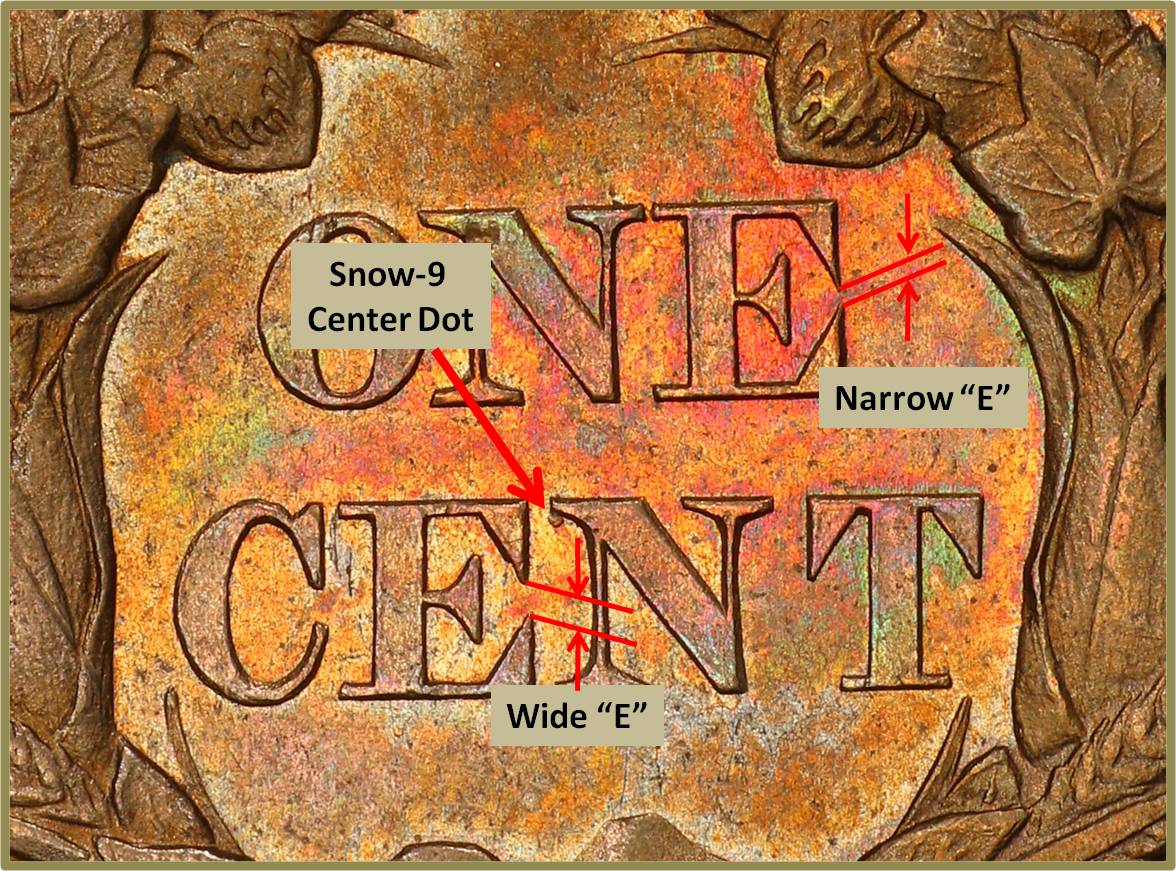 Comment: Comment:
Richard Snow outlines nicely the 1856 history in “A guide Book of Flying Eagle and Indian Head Cents”. It appeared the 1st batch of patterns were struck in Mint State and freely exchange hands within the government with hundreds of samples and most likely many made their way into circulation. After the 1857 Eagle production started and release collectors became interested in finding 1856 pieces. The mint director ordered additional Proof formats minted in 1858 . The Snow -9 Center Dot is the diagnostic for these “RESTRIKE” proof versions
|

|
|
View Coin
| J-184
1C Flying Eagle
Rev with Ornamental Shield |
United States
|
1C 1856 J-184
|
PCGS PF 62
|
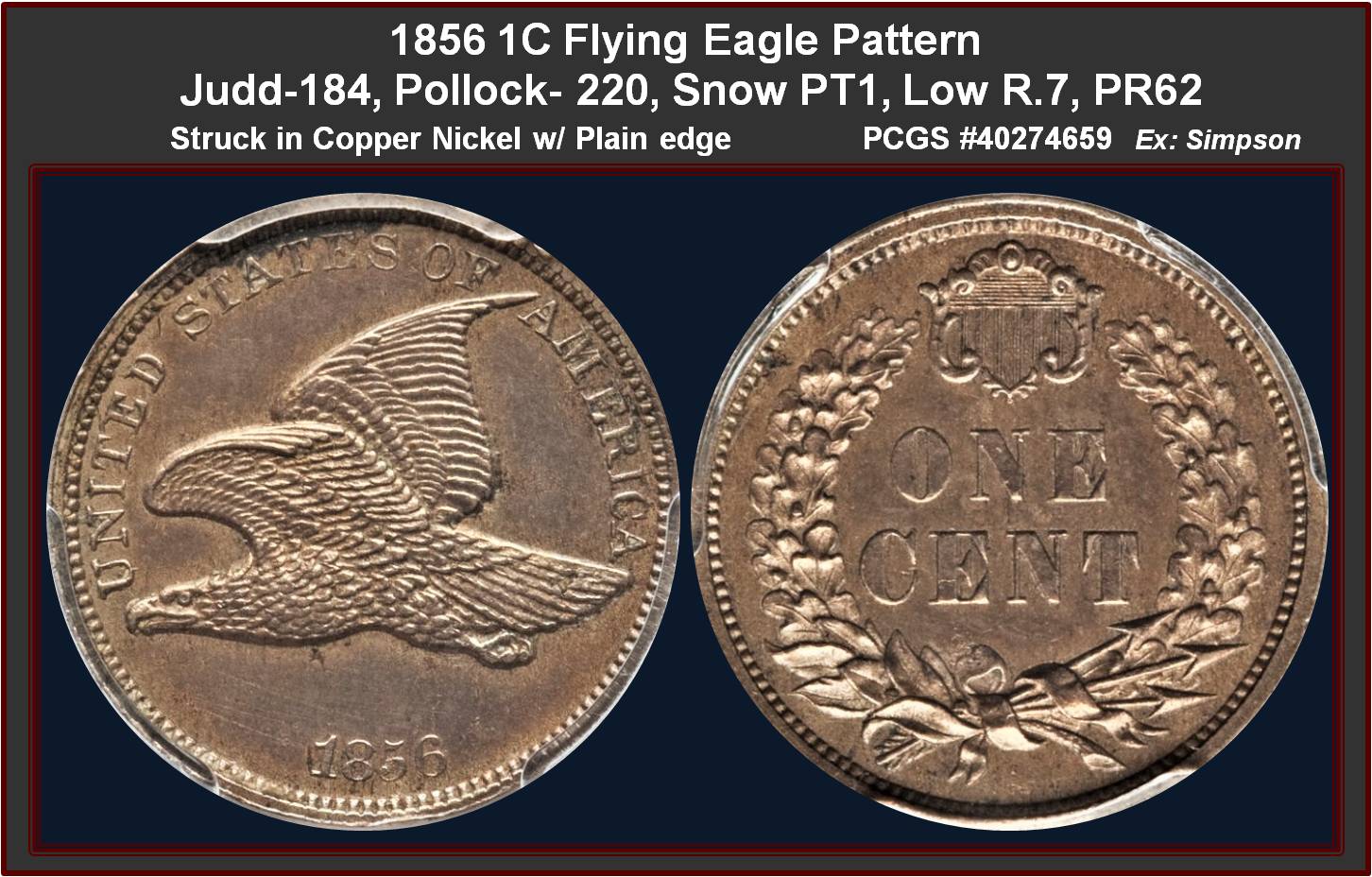
1856 1C Flying Eagle
Judd-184 Pollock-220, Snow-PT1,
Rarity: Low R.7. PF62
Ex: Simpson
Struck in copper-nickel with a plain edge.
Obverse: Was struck from the normal 1856 Flying Eagle cent dies, showing a flying eagle in a plain field with the legend UNITED STATES OF AMERICA and the date below. The O in OF is squared-off.
Reverse: Exhibits an oak wreath with ornamental shield above and the denomination ONE CENT in the center -- a design vaguely presaging the regular-issue reverse with shield and oak wreath of the 1860-1909 Indian cents.
Comment:
The dies correspond to Rick Snow's Die Pair 2, without a line below the amulets on the left side of the shield. Snow writes that probably not more than 25 Judd-184 representatives were struck at some point between 1856 and 1858. This PR62 example is tan-gold with violet, steel, and peach-orange accents. A couple of stray marks appear over the date.
Provenance/Appearances:
From Bob Simpson Collection Part 3, Heritage Jan 2021 Signature Auction / Lot #3074; Priors"
- Heritage Jan 1994 F.U.N. Bullet Sale #115 / Lot #1061;
- Bowers & Merena Jan 1985 / Lot #494
|

|
|
View Coin
| J-188 25C |
United States
|
25C 1857 J-188
|
PCGS PF 63 Brown
|
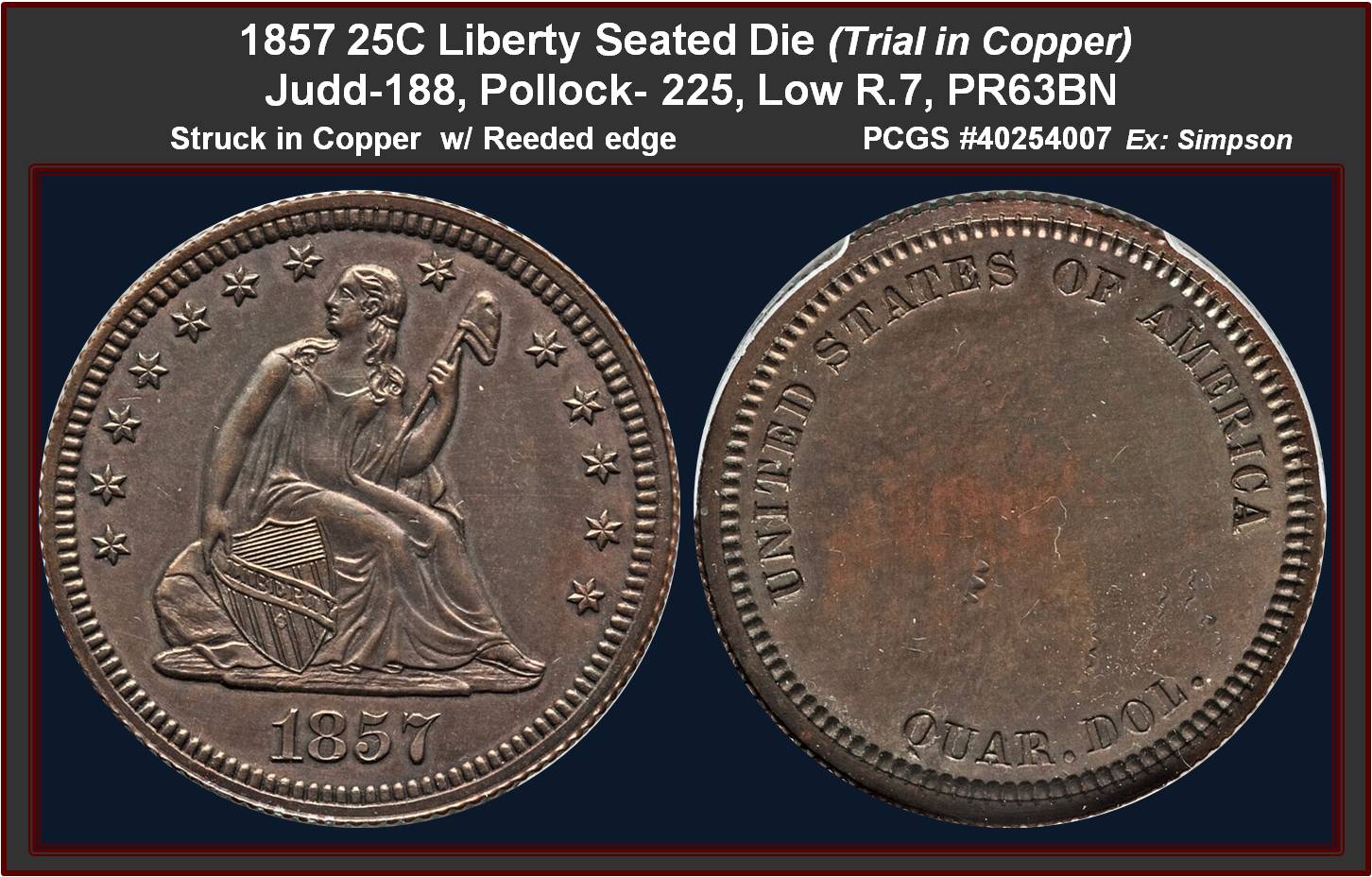
1857 25C Quarter Dollar
Judd-188, Pollock-225
Rarity: Low R.7, PR63 BN
Ex Simpson
Struck in copper with a plain edge
Obverse: The obverse is the regular-issue Seated Liberty quarter from 1857.
Reverse: Is from an incomplete die that shows UNITED STATES OF AMERICA and QUAR. DOL. at the rim in a smaller font than on the regular issues, with the letter Q shaped much differently. The center reverse is blank.
Commentary:
The Q in QUARTER is noticeably thin and squeezed, with a long serif descending from the center of the letter. Both sides offer subtle reddish-gold coloration, with a dollop of sage added to the reverse. A few reeding marks are noted in the center reverse, signs of contact with other coins (of the same issue, one might assume), but otherwise the surfaces are splendid and attractive, with a bold strike and excellent appeal.
Struck on both thick and thin planchets, this is another pattern variety that begs for a weight indication on the encapsulation. In earlier editions, the comment on this pattern in Judd was that it "appears to be the first work of Anthony C. Paquet who started working at the Mint on October 20, 1857." Perhaps a dozen exist on both thick and thin planchets according to USPatterns.com, and USPatterns states that this piece might have been a setup piece for Paquet's ten dollar design the following year, Judd-221.
Provenance/Appearances
From Bob Simpson , Heritage Aug 2021 ANA WFOM / Lot #3052; Priors
-Superior Jun 1992 (Jack Adams Collection) / Lot #2374 ( as Brilliant PF60BN );
- Ira and Larry Goldberg;s May 2003 / Lot #574 PCGS 62RB and
- Stacks Oct 16th 2003 Anniversary (Estate of Richard Hillman) / lot #2031, PR62 RB PCGS;
- Lemus-Queller Family Collection Heritage Jan 2009 Fun / Lot #15, NGC PR64BN ( This auction referred to from unknown Stacks Lot #2031?
|

|
|
View Coin
| J-189 2.5$ Gilt |
United States
|
$2.5 1857 J-189 GILT
|
NGC PF 64
|

1857 P$2 1/2 Quarter Eagle,
Judd-189, Pollock-226,
Rarity: Low R.7, PR64 Gilt
Ex: Bass
Plate piece in Pollock reference book Fig 89
Struck in Copper ( Gilt) with Reeded Edge
Obverse: The obverse depicts the portrait of Miss. Liberty facing left, with a coronet inscribed LIBERTY, virtually identical to that used on nickel three-cent pieces first made in 1865. At that later time Longacre did the easy thing and copied his 1857 die.
Reverse: An eagle with wings raised, having a shield on its breast. Three arrows and an olive branch are held by its claws. Around, the legend UNITED STATES OF AMERICA, and below, the denomination 2 1/2 D. The reverse design is in the style of Anthony C. Paquet, featuring a rather “surprised” appearing eagle— with thin wings, holding the requisite olive branch and arrows. Inscriptions in letters of the Paquet style surround.
Comments:
Light cameo contrast is evident on the brilliant yellow surfaces of this lovely pattern. A few scattered toning spots on each side may limit the grade, but they also provide convenient pedigree identifiers.
This is the low date variety with the digit 7 distant from Miss Liberty’s hair curl. This variety was discovered by Harry Bass who, during the 1970s, spent quite a bit of time studying patterns carefully under high magnification. His quest for different variations in punctuation, date placement, etc., explains his acquisition of multiple examples of certain.
Technical Aspects: Weight: 37.9 grains. Diameter: 17.7 mm. Die alignment: 180°. Die notes: On the present coin the date is lower in the field, with the 7 being about equidistant between a dentil and the curl.
Provenance/Appearances:
From The Estate of Charles W. Montgomery. Heritage Nov 2023 Dallas / Lot #3273: Priors
Ex: Harry X Boosel's "1873 Collection" (RARCOA, 4/1972), Lot 993;
Harry W. Bass, Jr. Collection (Bowers and Merena, 5/1999), lot 1333;
Superior (10/2000), lot 4456 (Passed);
Superior (3/2001), lot 619.
|

|
|
View Coin
| J-191
One Cent: Flying Eagle, Large Eagle Small Lts w/Laurel wreath
12 PC Set |
United States
|
1C 1858 J-191
|
PCGS PF 64
|

1858 1C Flying Eagle
J-191, Pollock-233, Snow-PT14a, Snow Die Pair II.
Rarity: R.5. PF64; CAC Endorsed & Eagle Eye Photo Seal.
Struck in Copper-Nickel with a Plain Edge
Obverse: The regular issue 1858 Flying Eagle cent die, Small Letters.
Reverse: Laurel wreath design, nearly the sane that as adopted for use on the Indian cent of 1859, but with clusters of five leaves instead of six. This is the more common of the dies variety.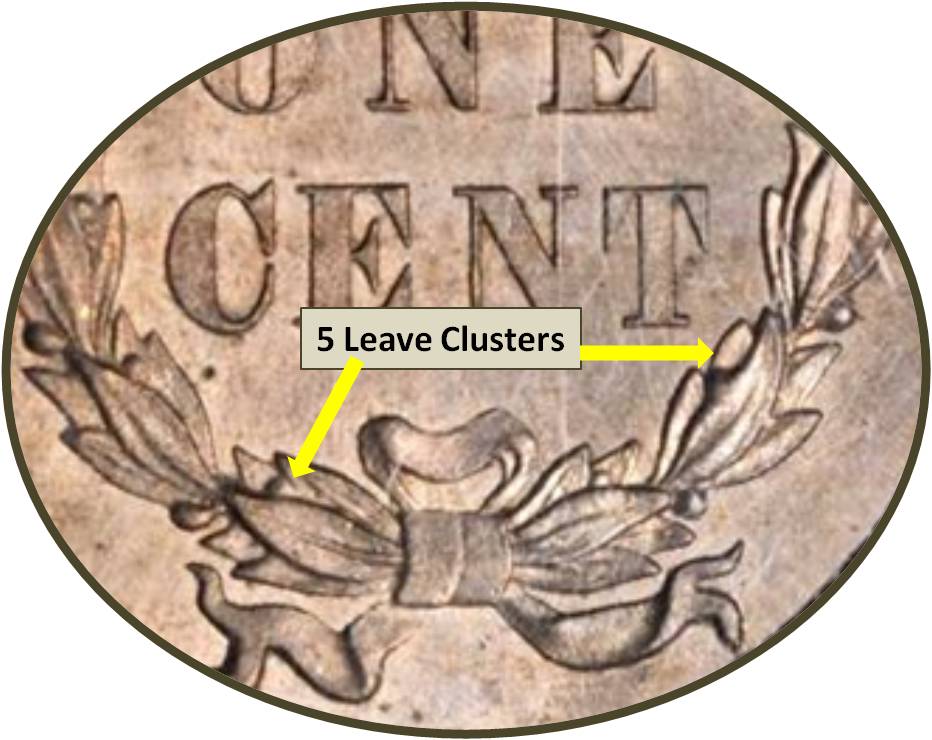
Comment:
Sharply struck on both sides, this pattern Flying Eagle cent is splendid and beautiful in every respect. Both sides retain noticeable amounts of the original "white" surface from the higher nickel alloy. Additionally a slight overlay of reddish patina is seen over each side, a bit deeper in hue on the reverse. The fields are deeply reflective as well, undoubtedly from the lack of any significant color.
This is one of the 12 1858 1c pieces part of the pattern sets distributed to Congress.
Provenance/Appearances:
Stacks and Bowers Nov 2016 Baltimore-Session 6 /Lot 4597; prior Provenance: From the Hoosier Flyer Collection Stacks Aug 2012 Philadelphia ANA /Lot 11207; Heritage Dec 2009 Houston / Lot #1452
|

|
|
View Coin
| J-192
One Cent: Flying Eagle, Large Eagle Small Lts w/Oak wreath
12 PC Set |
United States
|
1C 1858 J-192
|
PCGS PF 64
|

1858 1c Flying Eagle
Judd-192, Pollock-235, Snow-PT13
Rarity: R.5, PF64, CAC Endorsed and Photo Seal Endorsement
Struck in copper-nickel with a plain edge
Obverse is the familiar Small Letters 1858 cent.
Reverse Generally resembles the 1860 regular issue reverse, but there is no shield at the top and the closed oak wreath.Three arrows and olive sprig at the base of the wreath.
Comment: Heavy die polish lines and very few actual marks yields a stunning looking coin that is much better than the PCGS grade described. Nice reflective surfaces almost yielding a cameo effect.
This is one of the 12 1858 1c pieces part of the pattern sets distributed to Congress.
Provenance/Appearances
From Sale with Ric Snow Eagle Eye Coins Aug 2017 , Prior Goldberg Auctioneers Feb 13 2008 Pre Long Beach Sale #44 / Lot 2271
|

|
|
View Coin
| J-193
One Cent: Flying Eagle, Small Eagle w/oak wreath and ornamental shield
12 PC Set |
United States
|
1C 1858 J-193
|
NGC PF 62
|
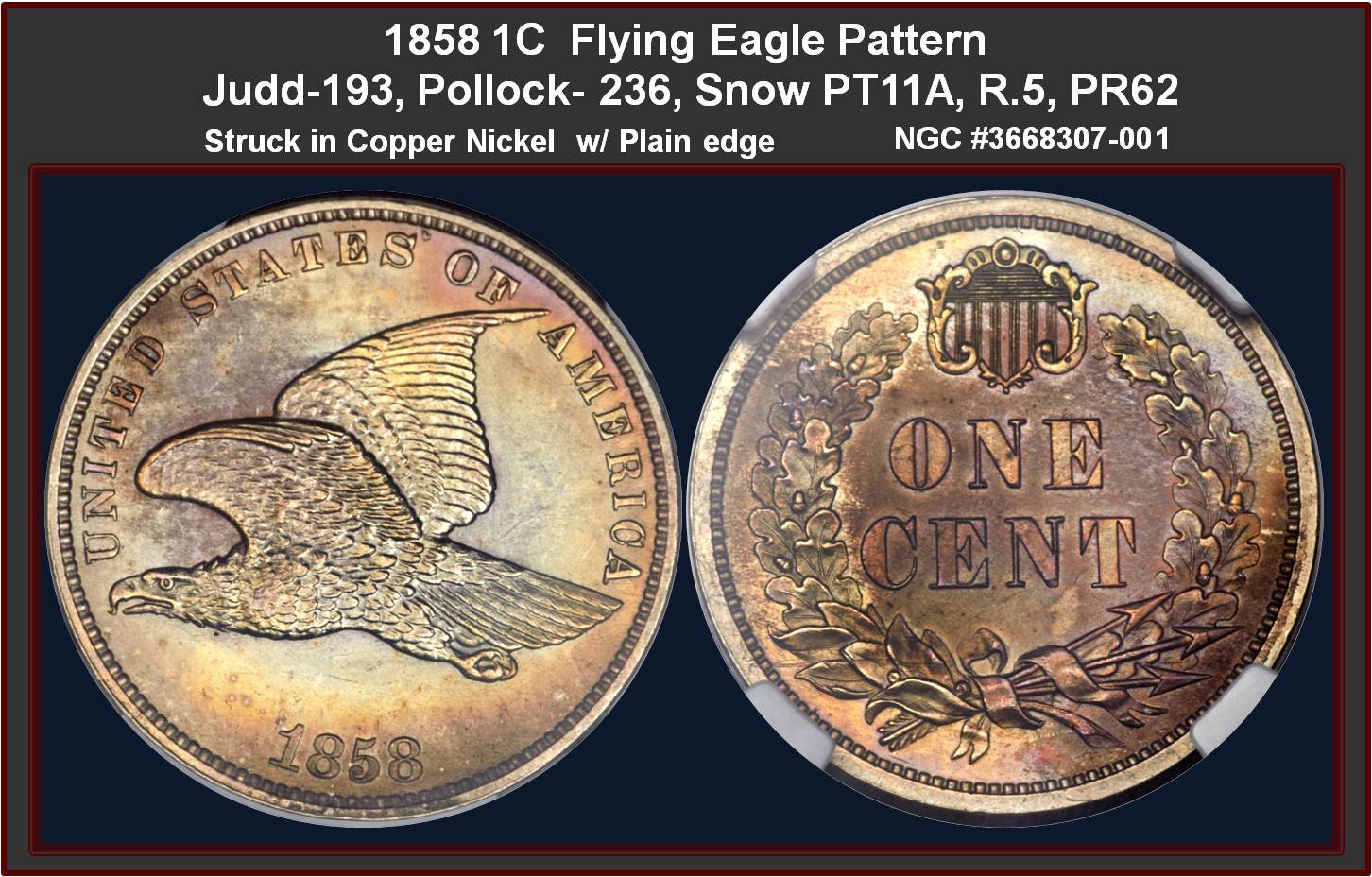
1859 1c Flying Eagle
Judd-193, Pollock-236, Snow-PT11a
Rarity:R 5, PF62
Struck in copper-nickel with a plain edge.
Obverse: Identical s the issued Small Letters 1858 Flying Eagle design,
Reverse: An oak wreath with a broad ornamental shield at top and a group of three arrows and an olive sprig bound at the bottom.
Blushes of rose-red and orange-gold enrich this satiny and fully struck specimen. The reverse is smooth while the obverse displays faint hairlines. Cameo effect with nice reflective fields
This is one of the 12 1858 1c pieces part of the pattern sets distributed to Congress.
Heritage 2013 April 24 - 28 CSNS US Coin Auction - Chicago / Lot #5318
|

|
|
View Coin
| J-202
One Cent: Flying Eagle- Hook Neck Small Eagle w/ Laurel Wreath
12 PC Set |
United States
|
1C 1858 J-202
|
PCGS PF 62
|

1858 1C Flying Eagle Small
J-202, Pollock-245
Rarity: R.5
Eagle Eye Photo Seal.
Struck in copper-nickel with a plain edge.
Obverse: The hook-necked (or Skinny) eagle design (usually attributed to Longacre)
Reverse: a simple laurel wreath with "ONE CENT" in the center. This piece has clusters of five leaves (Pollock-245) vs P-246 with six leaves and a bit scarcer.
Rich golden coloring with the fields nicely mirrored. A few minor specks limits the grade.
This is one of the 12 1858 1c pieces part of the pattern sets distributed to Congress
|

|
|
View Coin
| J-203
One Cent: Flying Eagle- Hook Neck Small Eagle w/ Oak Wreath
12 PC Set |
United States
|
1C 1858 J-203
|
PCGS PF 62
|
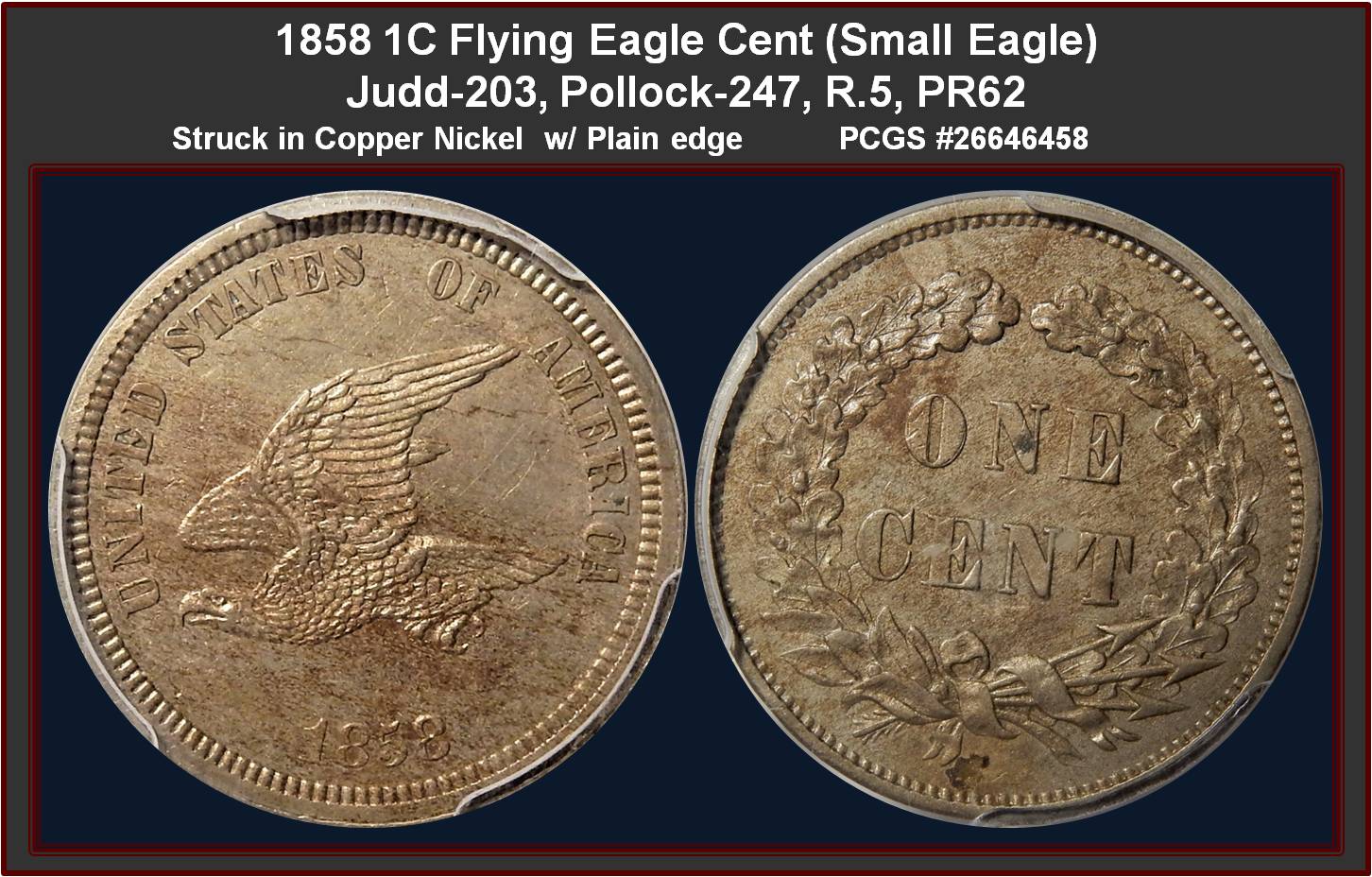
1858 Indian One Cent
Judd-203, Pollock-247
Rarity: R.5; PR62
Struck in copper-nickel with a plain edge
Obverse: The hook-necked small eagle flying left with tall wings.
Reverse: Oak wreath with the denomination "ONE CENT" in the center an olive sprig and a group of three arrows are wrapped into the bottom of the wreath.
Comment::
This is one of the 12 1858 1c pieces part of the pattern sets distributed to Congress
Provenance/Appearances:
Private Sale Feb 2013 ( No other appearance found)
|

|
|
View Coin
| J-204 1C
Small Flying Eagle
w/ ornamental shield |
United States
|
1C 1858 J-204
|
PCGS PF 62
|

1858 1C Flying Eagle
Judd-204 Pollock-248
Rarity: R.5
Struck in copper-nickel with a plain edge
Obverse: The hook-necked (or Skinny) eagle design (usually attributed to Longacre)
Reverse: Oak wreath with the denomination "ONE CENT" in the center and paired with an ornamental shield at the top.
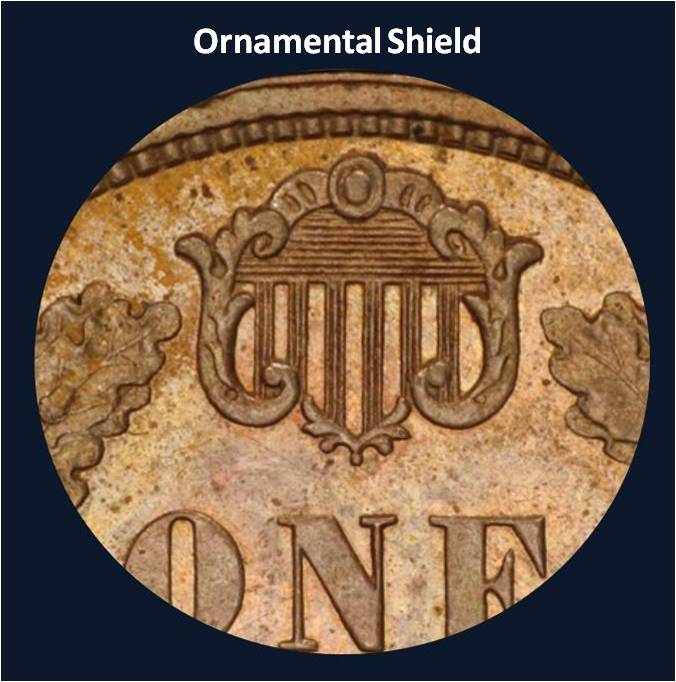
Overall very pleasing example
This is one of the 12 1858 1c pieces part of the pattern sets distributed to Congress
Counterfeits of this design exist and were mentioned by Paul Gilkes in the January 13, 1992 edition of Coin World
|

|
|
View Coin
| J-206
One Cent: Flying Eagle- Hook Neck Small Eagle w/ Agricultural Wreath
12 PC Set |
United States
|
1C 1858 J-206
|
PCGS PF 64
|

1858 1C Flying Eagle
Judd-206, Pollock-242, Snow-PT16
Rarity R.5, PF64
Struck in copper-nickel with a plain edge.
Obverse: Paquet's Small Eagle
Reverse: An agricultural wreath with the denomination "ONE CENT" in the center. The Low Leaves reverse. Slight hub doubling is evident on the reverse with the close E in ONE rehubbed with an open E.
This is one of the 12 1858 1c pieces part of the pattern sets distributed to Congress
Evenly mellowed and brown overall. At the right angle the mirrored fields still flash through the brown patina. Sharply struck throughout
Heritage 2017 January 4 - 9 FUN US Coins Auction - Fort Lauderdale / Lot #6493
|

|
|
View Coin
| J-208
One Cent: Indian Head- Transitional w/ Laurel Wreath
12 PC set |
United States
|
1C 1858 J-208
|
PCGS PF 64
|
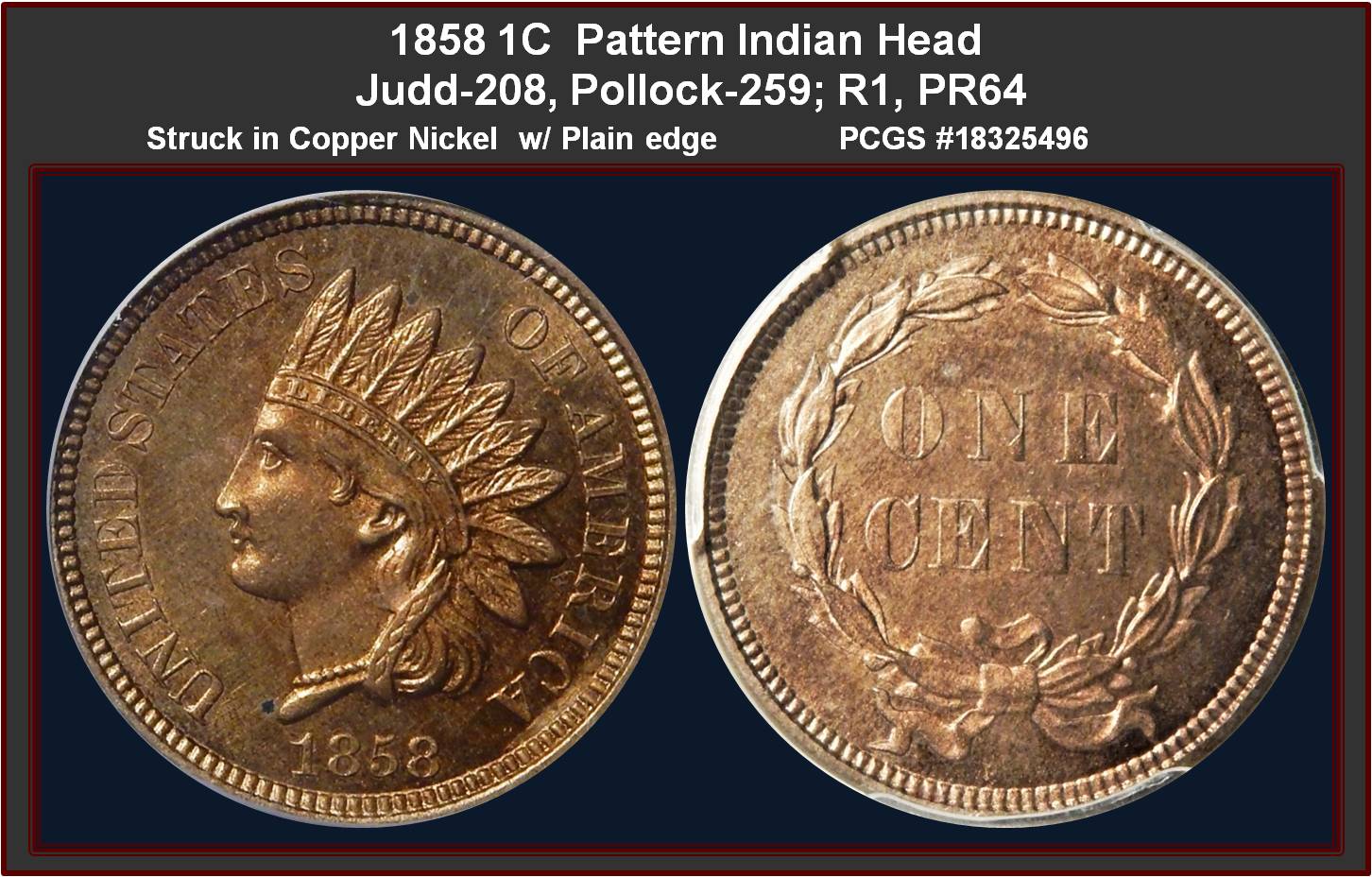
1858 1c Indian Head
Judd-208, Pollock-259
Rarity: R1. PF64
Struck in copper-nickel with a plain edge.
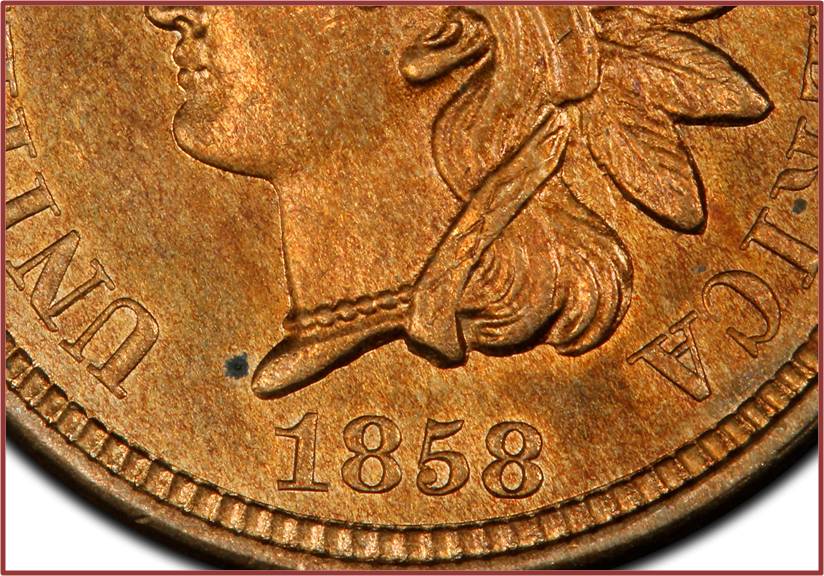 Obverse: Features the Indian design with Rounded Bust used to strike regular issue Cents from 1860 through early 1864. This is the Pollock/Snow subvariety with a centered date. Obverse: Features the Indian design with Rounded Bust used to strike regular issue Cents from 1860 through early 1864. This is the Pollock/Snow subvariety with a centered date.
Reverse: a laurel wreath with five leaf clusters surrounding “ONE CENT” in the center.
Sharp-to-full in strike, this bold-looking, reddish-tan example is kept from full Gem status by only a few wispy obverse carbon flecks. Popular pattern type!
Pedigree: From the G. Edward Reahl, Jr. M.D. Collection, Part II.
Stack's Bowers - The January 2011 Tampa Bay Rarities Sale Lot #1264
|

|
|
View Coin
| J-211
One Cent: Indian Head- Transitional w/ Oak Wreath
12 PC Set |
United States
|
1C 1858 J-211
|
PCGS PF 64
|

1858 Indian Cent
Judd-211, Pollock-262
Rarity:R.4, Eagle Eye photo seal Endorsed
Struck in Copper Nickel with Plain Edge
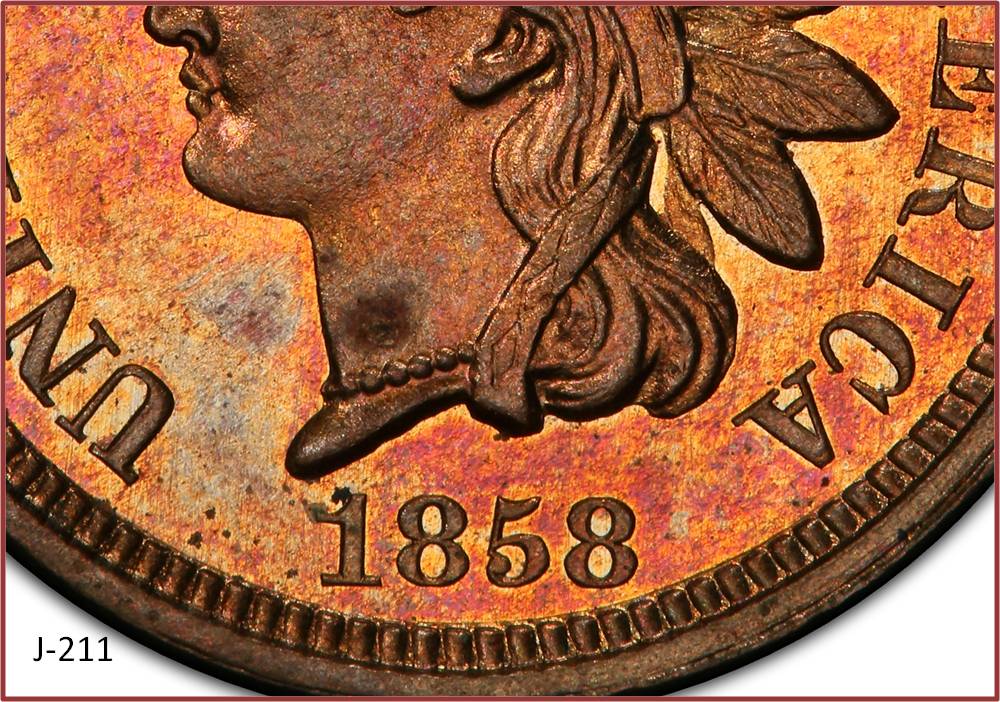 Obverse: Similar to the issued Indian cent, but is dated 1858. This is the centered date, broad bust point variant P-262 Obverse: Similar to the issued Indian cent, but is dated 1858. This is the centered date, broad bust point variant P-262
Reverse: Oak wreath with denomination "ONE CENT" in the center and 3 arrows tied off with olive Sprig at the bottom.
Provenance/Appearance:
Private transaction with Rick Snow of Eagle Eye Numismatics Sept 2020
|

|
|
View Coin
| J-212
One Cent: Indian Head- Transitional w/ Oak Wreath and ornamented Shield added
12 PC Set |
United States
|
1C 1858 J-212
|
PCGS PF 62
|

1858 1C Indian Head
Judd-212, Pollock-263, Snow-PT25,
RARITY: R.4,
PR62 Cameo W/ EAGLE EYE PHOTO SEAL.
Struck in copper-nickel with a plain edge
Obverse: Indian Bust same as used to coin regular issues from 1860 on, with a centered date.
Reverse: Oak wreath with denomination ONE CENT in center and a ornamental shield at top and 3 arrows and olive sprig tied at the bottom
Nicely reflective surfaces with traces of golden red color and frosted devices
This coin was part of a 12 coin set of transitional patterns struck as a replacement for the Flying Eagle cent.
|

|
|
View Coin
| J-213
One Cent: Indian Head- Transitional w/ cereal wreath
12 PC Set |
United States
|
1C 1858 J-213
|
PCGS PF 64
|

1858 1C Indian
Judd-213, Pollock 252 Low date Variety
Rarity:High R6 - Low R7, PR64
Struck in copper-nickel with plain edge
Obverse: Indian Head with a pointed bust truncation, faces left, with the date below and the legend UNITED STATES OF AMERICA around the periphery (the adopted obverse for the Indian Head cent of 1859.)
Reverse: denomination ONE CENT within a wreath of corn, wheat, cotton, and tobacco leaves with the ribbon tips distant from the wreath. This variant the leaft that is closest to the C to about even with the base of the C 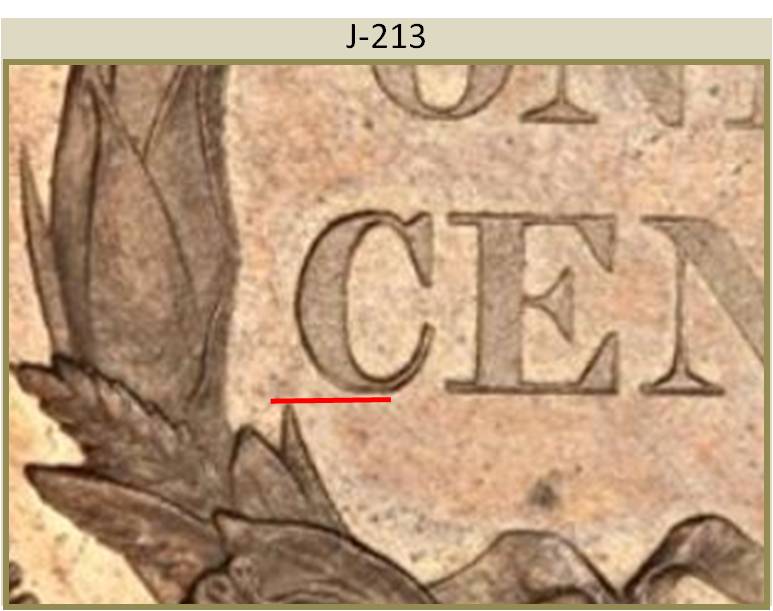
the J-213 is represented by 4 different die marriages, which gives it an overall rating of R-5 in the Judd reference book. The Low Date varieties are scarcer, with perhaps fewer as High R-6 < 18 pieces .
This coin was part of a 12 coin set of transitional patterns struck as a replacement for the Flying Eagle cent. Like the other patterns in the set, there were combinations of dies used, this one with a Low Date, there are two Pollock numbers assigned to these, with a combined estimate of about 18 known.
The reflective surfaces can be seen in the light, and the strike is bold throughout, especially on the reverse which is known to be weakly struck at times.
The Regency Auction XIX December 2016
|

|
|
View Coin
| J-221
25C
Liberty seated |
United States
|
25C 1858 J-221
|
PCGS PF 63
|
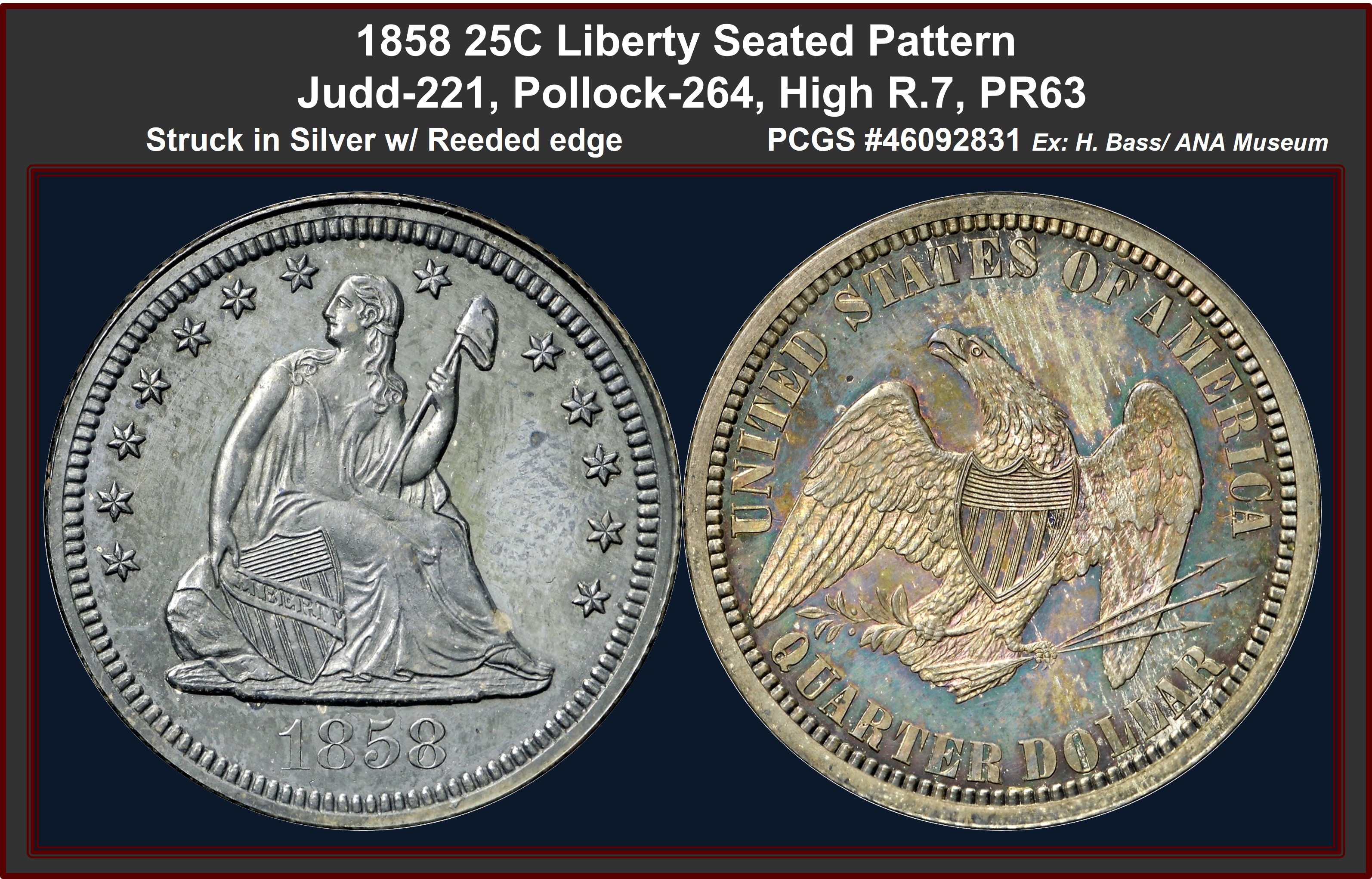
1858 25C Quarter Dollar
Judd-221, Pollock-264,
Rarity: High R.7, PR63
Ex: Harry W. Bass, Jr. Collection.
Plate Coin for type in Andrew Pollock reference (Fig 115)
Struck in Silver with reeded Edge
Obverse: Liberty seated on rock, holding shield and liberty pole with cap, 13 stars around, date below base of rock.
Reverse: Eagle with outspread wings, shield on breast, sprig of olive and three slender arrows in its talons, UNITED STATES OF AMERICA QUARTER DOLLAR around.
Comment:
Anthony C. Paquet joined the Mint engraving department in 1857 and almost immediately starting preparing his own designs for several denominations. This example features the normal obverse employed for regular-issue coinage with a reverse design prepared by Paquet. Note especially the lettering that features tall, slender lines with extended serifs. The eagle is of different proportions with larger wings and smaller claws. Also note the delicate features of arrows and olive branch. All of these design elements point to Paquet as designer of this reverse. Although he also prepared other designs, Paquet is most known for his 1861 double eagle.
Saul Teichman of USPatterns.com has identified five distinct examples of Judd-221, including this Bass Core Collection example. This Select proof features gunmetal-blue and golden-olive patina overall with splashes of rainbow color on the reverse.
95.5 Grams, Dia .948 ", die Alignment 180 Deg
Provenance/Appearances:
From The Harry W. Bass, Jr. Core Collection, Part I. Heritage Sept 29, 2022 29 Signature® Auction - Long Beach / Lot #11078, and the Plate Coin for type in Andrew Pollock reference (Fig 115)
Prior ANA Sale (Stack's, 8/1976), lot 3589.
|

|
|
View Coin
| J-336 25C |
United States
|
25C 1863 J-336
|
PCGS PF 67 Red Brown
|

1863 25C Quarter Dollar,
Judd-336, Pollock-408,
Rarity: Low R.7, PR67 Red and Brown
Ex: Harry W. Bass, Jr. Collection.
Struck in Copper with Reeded Edge
Obverse: Similar to the regular-issue Seated quarter of the year.
Reverse: The reverse is also similar in design but bears the With Motto motif on a scroll, as adopted officially in 1866.
Comment:
These Motto patterns were actually struck around 1869 or 1870, according to USPatterns.com. About a dozen examples of Judd-336 are known.
Flashy proof surfaces are magnificently toned in shades of orange, magenta, and violet. Essentially void of contact and carbon.
91.8 grains, diameter 0.957", die alignment 180 deg
Provenance/Appearances:
From The Harry W. Bass, Jr. Core Collection, Part II. Heritage Jan 2023 Fun Lot # 9066, Harry Bass acquired this piece in trade from Numismatics Ltd. (8/12/1972).
|

|
|
View Coin
| J-226
1C Indian
Oak Wreath |
United States
|
1C 1859 J-226
|
PCGS PF 64
|

1859 1C Indian
Judd-226, Pollock-270, Snow-PT2
Rarity: High R.6, PR64, CAC Endorsed
Ex: Simpson.
Struck in copper-nickel with a plain edge.
Obverse: The same Indian Bust as the issued 1859 cent with the pointed bust truncation.
Reverse: Resembles the issued cent reverse of 1860 with the oak wreath and "ONE CENT" denomination in the center but lacks a shield at the top.
Comment:
This obverse / reverse pairing is scarcer than most Indian cent patterns from this era with fewer than a dozen pieces known. This is a deeply mirrored example whose obverse is several shades lighter than the reddish-tinged reverse. Light carbon specking is scattered over each side.
Interesting that this is a seldom seen pattern especially since it viewed as High R.6 Rarity with some 20 pieces extant
Provenance/Appearances:
From the Bob Simpson Sale Part 4 Heritage Feb 2021 Dallas Signature Auction /Lot #3148
Superior Jun 1977 (Dr. Walter Lee Crouch Collection) / Lot #82
|

|
|
View Coin
| J-227
One Cent: Indian Head - w/ ornamental scroll /Shield |
United States
|
1C 1859 J-227
|
NGC PF 63
|
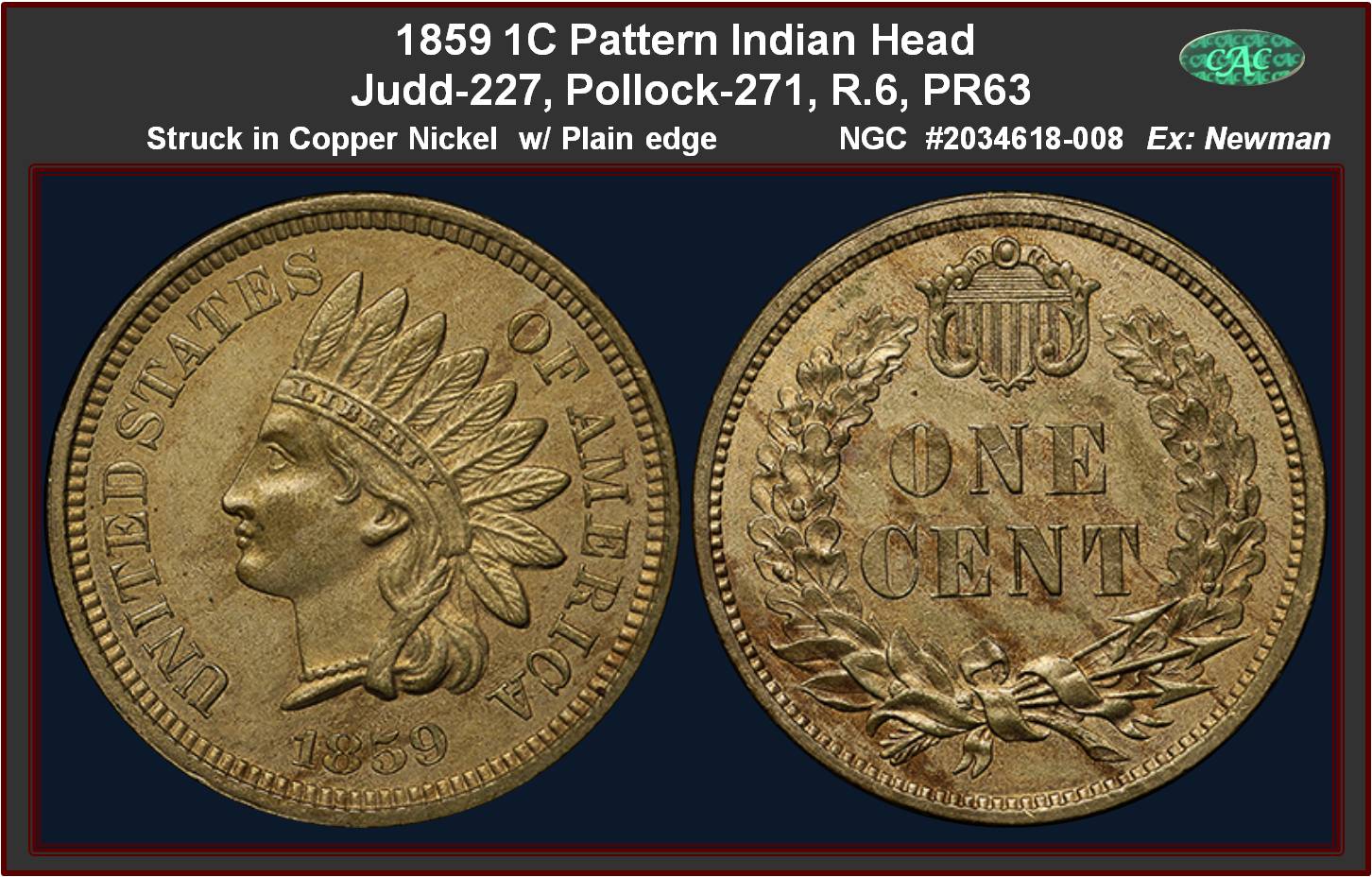
1859 Indian Cent
Judd-227, Pollock-271
Rarity Low R.6, CAC.endorsed
Ex: The Eric P. Newman Collection
Struck in copper-nickel with a plain edge
Obverse: The same Indian Bust as the issued 1859 cent with the pointed bust truncation.
Reverse: Resembles the issued cent reverse of 1860 with the oak wreath and "ONE CENT" denomination in the center but with a broad ornamental shield has been added at the top.
Comment:
This attractive Select specimen exhibits sharply detailed design elements and matte like surfaces on the obverse, with just a few hints of reflectivity. The reverse is equally sharp, with a lighter, satiny appearance overall. Areas of light brown toning mix with the original orange-red. The overall effect is quite appealing
A side note per Heritage catalog was an early auction appearance was in lot 108 of the Lorin G. Parmelee Collection (New York Coin & Stamp), where it was listed in the pattern section along with an example of Judd-228:
"1859 Cents: Indian heads (adopted type). R oak wreath: garnished and plain shields: former rare: cop-nickel: uncirc.; 3 pcs."
From the cataloger's comments, Judd-227 must have been a more challenging issue in 1890 than it is today. Perhaps several examples surfaced in William Woodin's hoard in 1910.
Provenance/Appearance:
From The Eric P. Newman Collection Heritage April 2013 CSNS Signature Auction - Chicago / Lot #3923; Prior "Colonel" E.H.R. Green; Green Estate; Partnership of Eric P. Newman / B.G. Johnson d.b.a. St. Louis Stamp & Coin Co.; Eric P. Newman @ $12.50; Eric P. Newman Numismatic Education Society.
.
|

|
|
View Coin
| J-228
One Cent: Indian Head - Transitional Cu-Ni
PCGS |
United States
|
1C 1859 J-228
|
PCGS MS 66
|
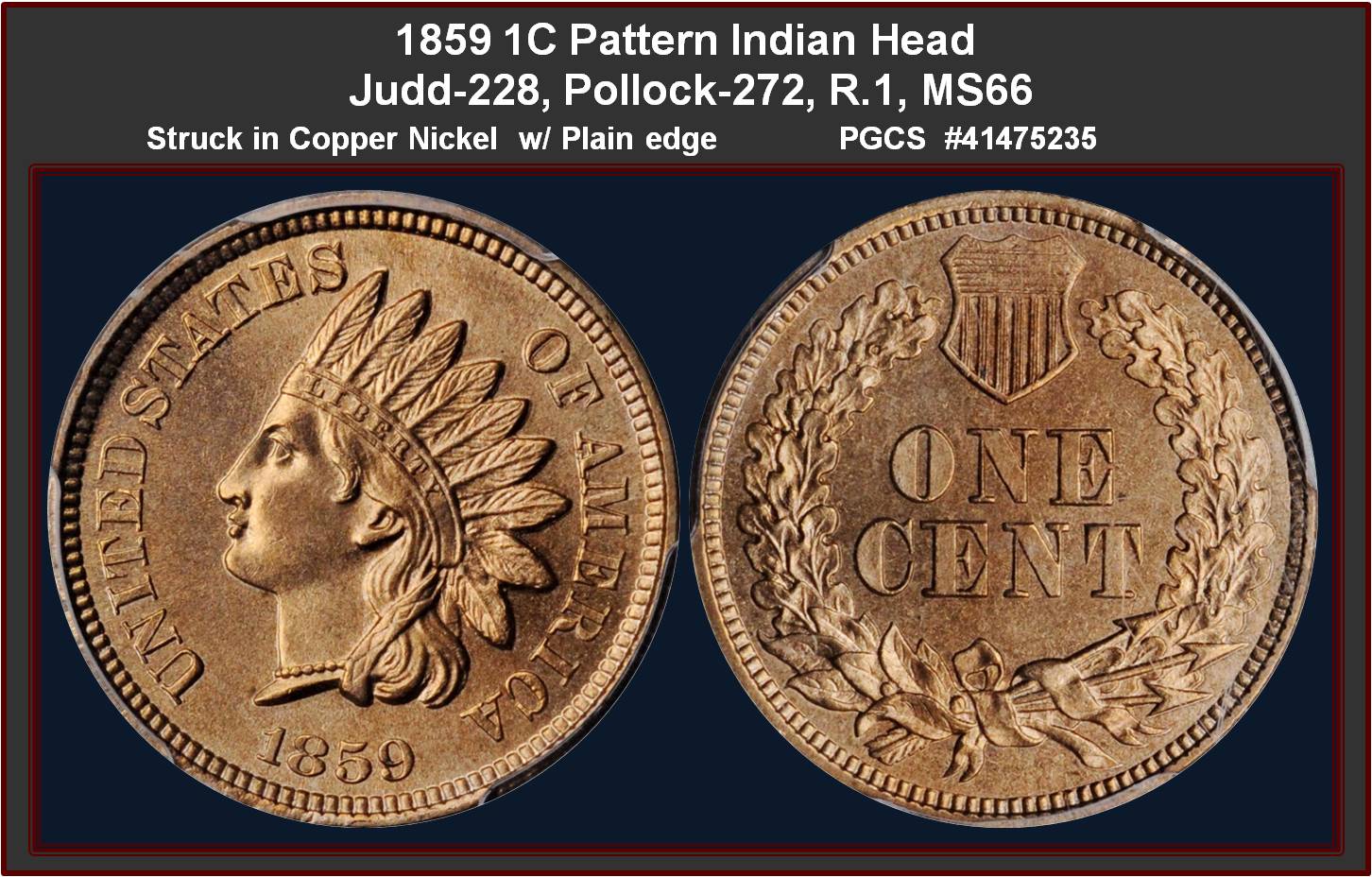
1859 Indian One Cent
Judd-228, Pollock-272.
Rarity: R.1, PR66
Struck in Copper-Nickel with Plain Edge.
Obverse: The same Indian Bust as the issued 1859 cent with the pointed bust truncation.
Reverse: Again this resembles the issued cent reverse of 1860 with the oak wreath and "ONE CENT" denomination the in the center and teh 3 arrows and Olive Sprig at the bottom but this one includes the Formal Federal shield at the top as used from 1860 on.
Comment:
This mint state example displays blended shades of golden-bronze adorn each side of this superior Gem, accented by tremendous proof like reflectivity in the fields. This is a popular transitional issue, circulation strike survivors of which are almost exclusively in Mint State, as this one. This fact suggests that these coins were distributed to collectors, possibly in trade for items to grow the Mint Cabinet collection. This example is among the finest survivors known.
Provenance/Appearance:
Stacks and Bowers March 2021 Featuring the Fairmont Collection / Lot 5601; Prior: Ex Bowers and Ruddy Galleries, privately circa 1980
|

|
|
View Coin
| J-235
50C Seated Liberty with fasces
Eagle Reverse
Silver |
United States
|
50C 1859 J-235
|
PCGS PF 63
|
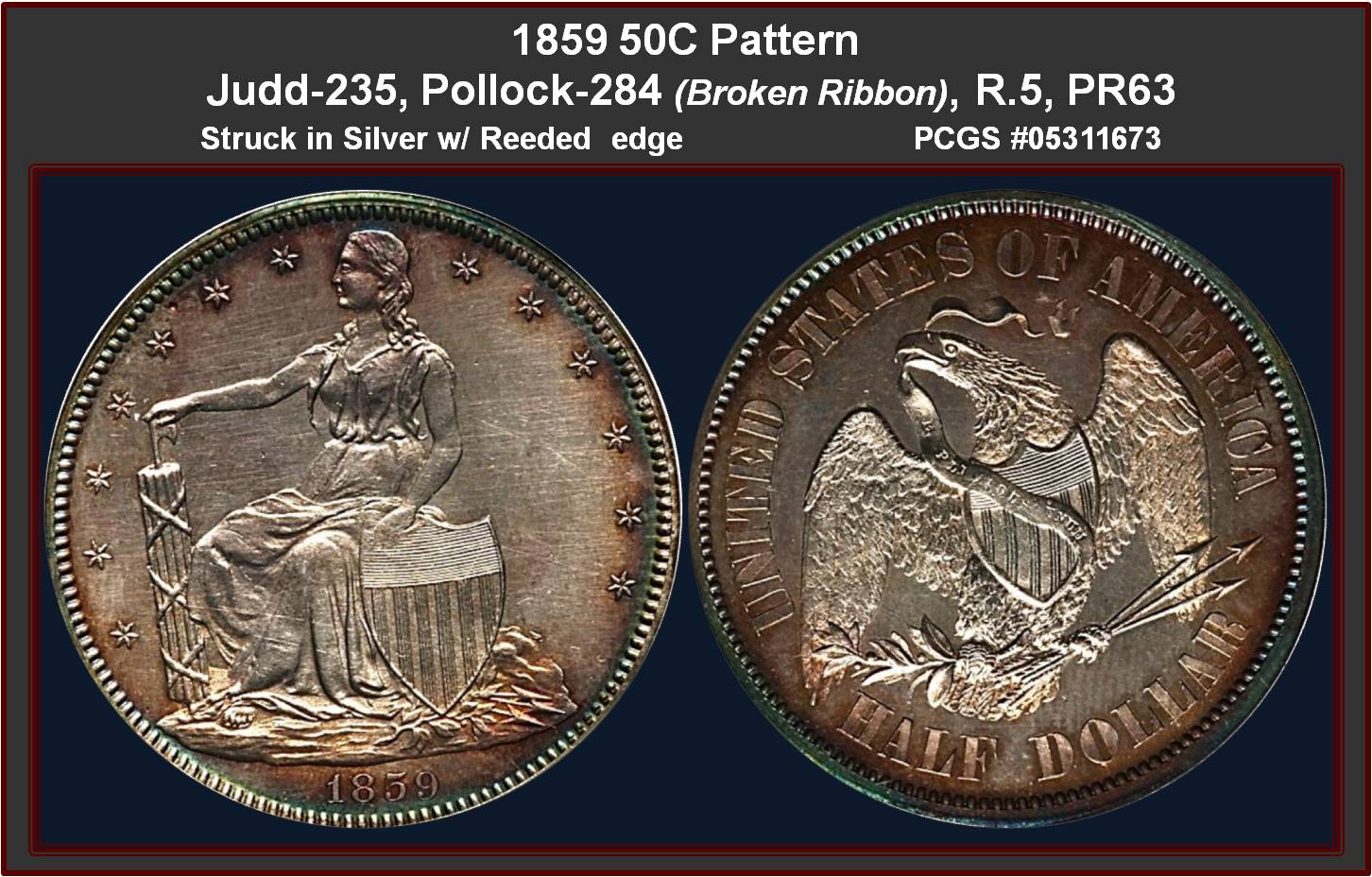
1859 50C
Judd-235 Pollock-284
Rarity: R.5 PR63
Struck in silver with a reeded edge
Obverse: Anthony Paquet's design offers a seated Liberty facing left. She supports a fasces with her right hand and balances a shield in her left. There are thirteen stars around the perimeter and the date at the base.
Reverse: Features Paquet’s large standing eagle with wings extended and a shield on its breast. Olive branch and lengthy arrows in the claws and holding a ribbon in its beak with E PLURIBUS UNUM inscribed. UNITED STATES OF AMERICA is above and the denomination HALF DOLLAR is below
Comment:
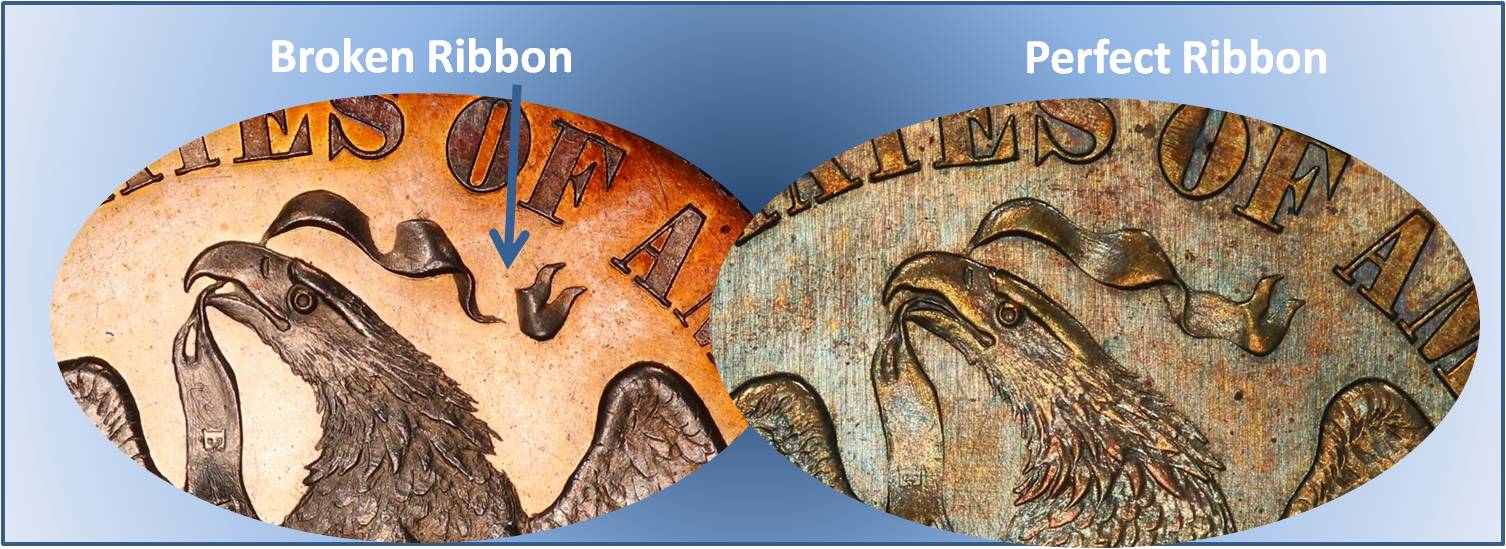 This is Pollock variant know as a “Broken Ribbon" reverse. The ribbon looks as it is in 2 two pieces at the right end. The “Broken Ribbon” effect was possibly due to either insufficient pressure of the hub die into the working die, thus not bringing out certain features of the ribbon into proper relief or it could have been from resurfacing of the die once it was prepared. This is Pollock variant know as a “Broken Ribbon" reverse. The ribbon looks as it is in 2 two pieces at the right end. The “Broken Ribbon” effect was possibly due to either insufficient pressure of the hub die into the working die, thus not bringing out certain features of the ribbon into proper relief or it could have been from resurfacing of the die once it was prepared.
In addition to the “Broken Ribbon” there were other variations as the Eagle left wing tip is rounded and the “RED” vertical strips in the shield have three lines each and the “white” strips in the shield are narrow. The eagle has six tail feathers.
A well struck specimen with moderate cameo contrast and pleasing peripheral peach-gold, ruby-red, and blue-green toning. The obverse is moderately hairlined.
Provenance:
Heritage 2013 August 8 - 10 US Coin Auction - Rosemont / Lot #4875
====================================================
Set of Paquet's and Longacre 50C Patterns of 1859
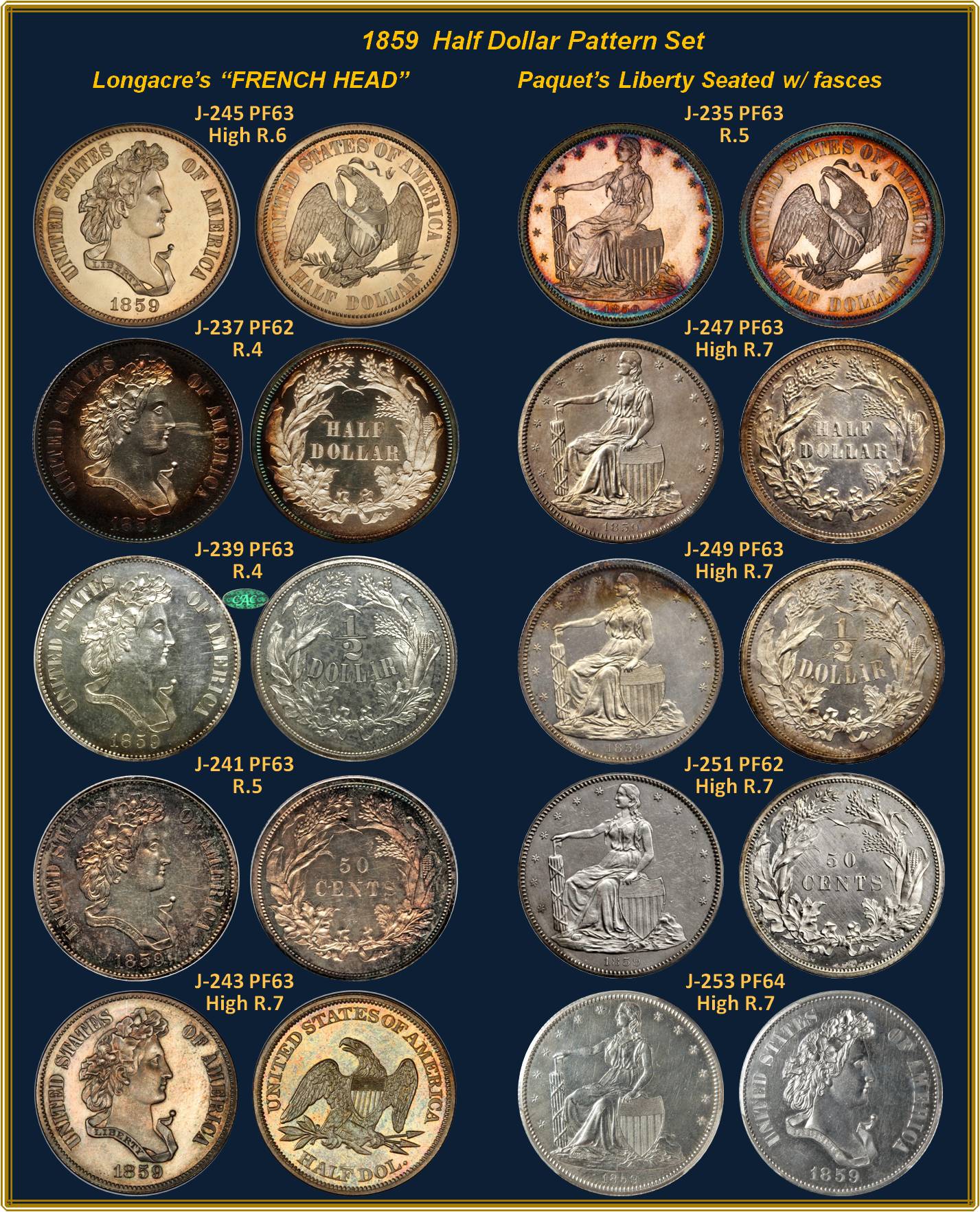
|

|
|
View Coin
| J-236
50C Seated Liberty with fasces
Eagle Reverse
In Copper |
United States
|
50C 1859 J-236
|
PCGS PF 65 Brown
|

1859 50C
Judd- 236 Pollock-283
Low R.6, PF65BN
Struck in copper with a reeded edge
Paquet's Seated Liberty with eagle reverse
Obverse: Anthony Paquet's design offers a seated Liberty facing left. She supports a fasces with her right hand and balances a shield in her left.
Reverse: Features a large eagle with an olive branch and lengthy arrows in the claws. This Pollock variant is the “Perfect Ribbon" reverse. Along with the ribbon looking as one piece the Eagle left tip is pointed. Also the “RED” strips in the the shield are four lines each and the :white” strips in the shield are broad. The eagle has seven tail feathers
Comment:
A lovely brown example with deep mirrors of violet, dark blues brown hues emanating as rotating the piece
The strike is full and sharp, and the surfaces exceptionally clean. Free of spots or other common annoyances, and a handsome example of this pattern coin.
Provenance: Appearances: :
Private sale Mar 2020
|

|
|
View Coin
| J-237 Silver
50C - French Liberty Head
"50 CENTS" Revers |
United States
|
50C 1859 J-237
|
PCGS PF 62
|

1859 50C French Head
Judd-237 Pollock-293
Rarity: R.4; PF 62
Struck in silver with a reeded edge
French Liberty Obverse Half Dollar with Half Dollar Reverse
Obverse: A bust of Liberty faces right with laurel and vine in her hair. A ribbon below the bust is inscribed LIBERTY, with UNITED STATES OF AMERICA around, and the date 1859 below.
Reverse: Displays the agricultural wreath of the Seated dime, resized to appropriate scale, around the denomination HALF DOLLAR. .
Comment:
This is a splendid, originally toned example of the James B. Longacre French Head design, with much more eye appeal than the grade might suggest. Silver centers cede to burnt orange and aqua on each side, but more prominently so on the obverse. A few field hairlines are visible on each side, even without a loupe, but are not overly distracting.
Provenance:
Heritage April 2012 Schaumburg / Lot #6260
====================================
Set pf 1859 Longacer "French Head" Patterns

|

|
|
View Coin
| J-238 Copper
50C - French Liberty Head
"50 CENTS" Reverse |
United States
|
50C 1859 J-238
|
PCGS PF 65 Brown
|
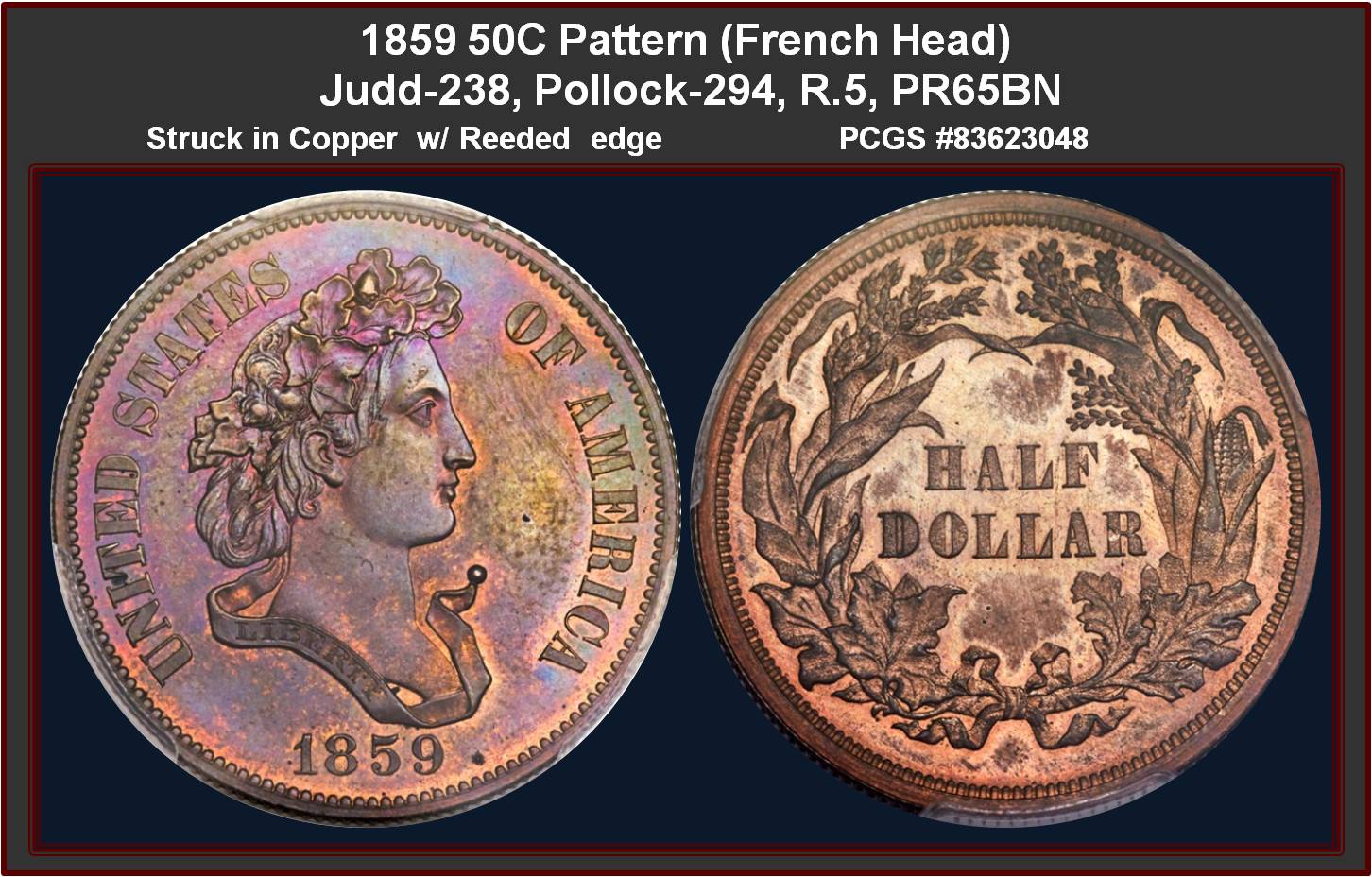
1859 50C
Judd-238 Pollock-294
Rarity: R.5, PF65BN
Struck in copper with a reeded edge.
Longacre's French head with HALF DOLLAR reverse
Obverse: Longacre's so-called "French Head" of Liberty, which faces right, draped with a ribbon inscribed LIBERTY and a wide wreath of oak and vine on her head.
Reverse: A wreath composed of Cotton, tobacco, sugar cane,corn, wheat, and oaks leaves with "HALF DOLLAR" in the center,
Comment:
Saul Teichman expresses doubt on USPatterns.com whether this design was actually designed by James Longacre or by Anthony Paquet. The reason for the uncertainty stems from the punches used in UNITED STATES OF AMERICA were those of Paquet.
The obverse is uniformly muted by brown patina, while still showing slight traces of red around the devices. The reverse, on the other hand, is more red than brown and quite vibrant.
Provenance:
Heritage June 8 2017 Long Beach Expo / Lot #4660
|

|
|
View Coin
| J-239 Silver
50C - French Liberty Head (1/2 Dollar on Reverse) |
United States
|
50C 1859 J-239
|
PCGS PF 64
|
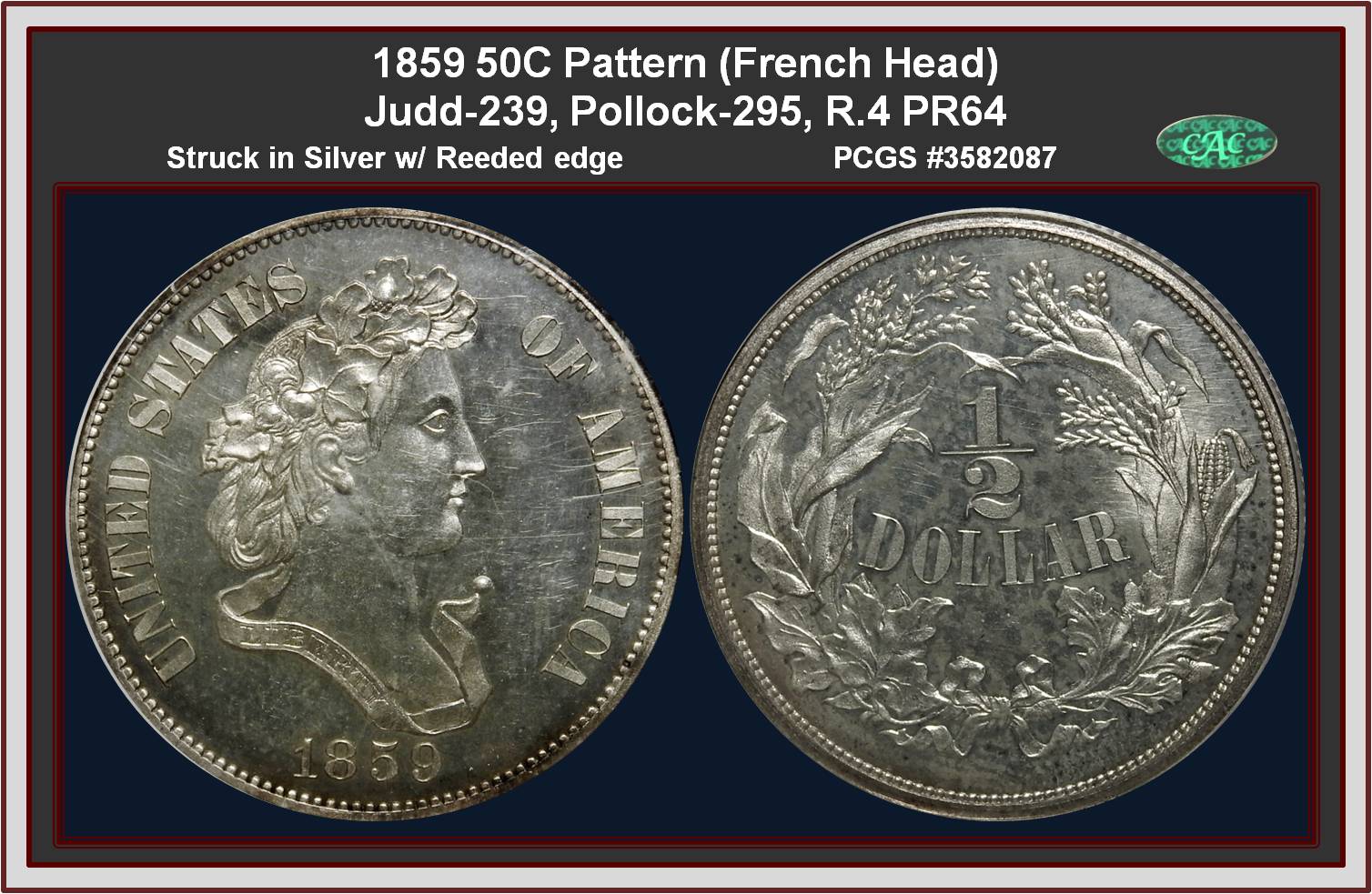
1859 50C French Head
Judd-239, Pollock-295
Rarity: R.4, PF64 CAC Endorsed
Struck in silver with a reeded edge.
Obverse: Longacer's "French Head" Liberty facing right, draped with a ribbon inscribed LIBERTY with a wide wreath of oak and vine on her head.
Reverse: 1/2 DOLLAR in the center and is surrounded by a “cereal wreath” composed of cotton, tobacco, corn, sugar cane, wheat, and oak.
Comment:
Mint Director James Ross Snowden commented that this reverse design was deliberately prepared to admit perfect striking of the head on the obverse. Snowden attributed the reverse design to Anthony Paquet.
Brilliant, with gold at the rims, above average strike and luster, flashy, silver,
Provenance:
The A. James Evans Collection, Part II, Heritage 2015 January FUN - Orlando / Lot #6704
|

|
|
View Coin
| J-240 Copper
50C - French Liberty Head (1/2 Dollar on Reverse) |
United States
|
50C 1859 J-240
|
PCGS PF 65 Red Brown
|

1859 50C French Head
Judd-240, Pollock-296
Rarity: R.5m PF65RB
Struck In copper with Reeded Edge
Obverse: Longacre's "French Head" Liberty faces right with a oaks and vine wreath in her hair. A ribbon below the bust is inscribed LIBERTY, with UNITED STATES OF AMERICA around, and the date below.
Reverse: The denomination "1/2 DOLLAR" within an agricultural wreath of cotton, tobacco, sugar cane, corn, wheat, and oak leaves. The wreath Motif on these 1859 pieces is identical, except for scale, as its counterparts on the issued 1860 half dime and dime.
Comment:
The wreath motif is identical, except for scale, as its counterparts on the issued 1860 half dime and dime.
Well-struck and undisturbed with beautiful sea-green, powder-blue, and cherry-red toning
|

|
|
View Coin
| J-241 Silver
50C - French Liberty Head (Half Dollar Reverse) silve |
United States
|
50C 1859 J-241
|
PCGS PF 63
|
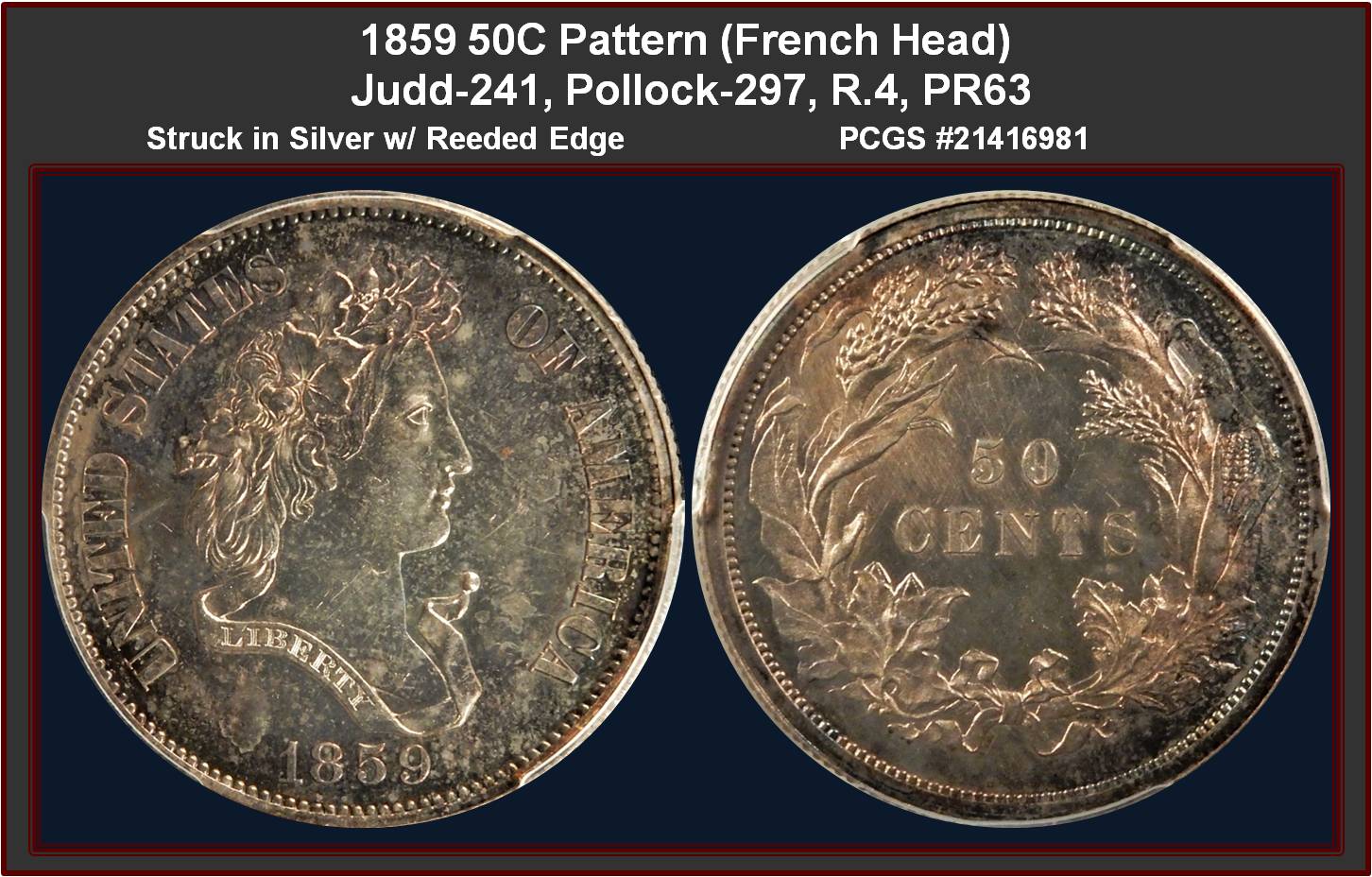
1859 50C "French Head"
Judd- 241, Pollock-297,
Rarity: R.4, PF63
Struck in silver with a reeded edge
Obverse: Longacre's "French Head" Liberty faces right with a oaks and vine wreath in her hair. A ribbon below the bust is inscribed LIBERTY, with UNITED STATES OF AMERICA around, and the date below.
Reverse: The denomination "50 CENTS" within an agricultural wreath of cotton, tobacco, sugar cane, corn, wheat, and oak leaves.
Comment:
The wreath motif is identical, except for scale, as its counterparts on the issued 1860 half dime and dime.
This is a brightly reflective example whose interiors are close to untoned (but not quite), while the margins exhibit wide rings of russet and blue patina.
Provenance/ Appearances:
Heritage 2020 January 8 - 12 FUN US Coins Signature Auction - Orlando Lot #5860
|

|
|
View Coin
| J-242 50C
French Head |
United States
|
50C 1859 J-242
|
PCGS PF 64 Red Brown
|

1859 P50C Half Dollar,
Judd-242, Pollock-298,
Rarity: R.5, PR64RB
Ex Simpson
Struck in copper with a reeded edge,
Obverse: Longacre's "French Head" Liberty faces right with a oaks and vine wreath in her hair. A ribbon below the bust is inscribed LIBERTY, with UNITED STATES OF AMERICA around, and the date below.
Reverse: The denomination "50 CENTS" within an large agricultural wreath of cotton, tobacco, sugar cane, corn, wheat, and oak leaves.
Comment:
These 1859 busts are often credited to Chief Engraver Longacre though the narrow lettering style of the legends is associated with Anthony Paquet. Its apparent inspiration was the Neoclassical statue of the Apollo Belvedere, but the "French Head" label remains a mystery.
Vivid shades of pale jade, lavender, and russet patina blankets the well-preserved surfaces of this attractive Choice proof, with sharply detailed design elements underneath. Some minor carbon specks are evident on the obverse.
Provenance/Appearances:
From The Atherton Collection of U.S. Pattern Coins, Heritage May 2023 CSNS Signature® Auction / Lot #4924 , Prior Ex: Important Selections from The Bob R. Simpson Collection, Part IV (Heritage, 2/2021), lot 3150.
|

|
  
 | Loading… |
|
|